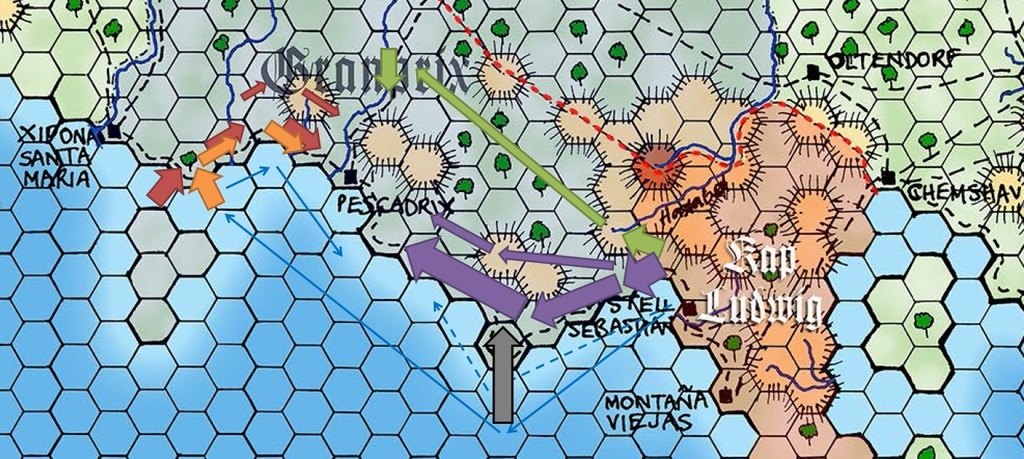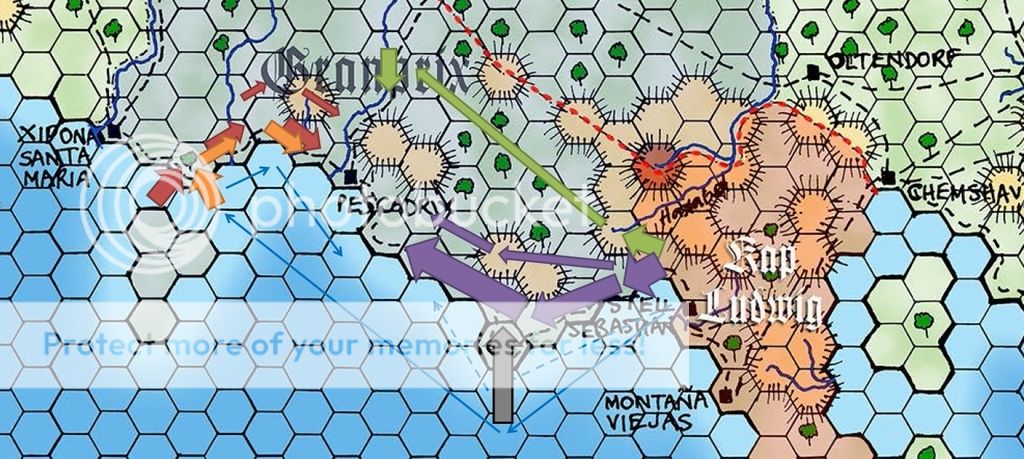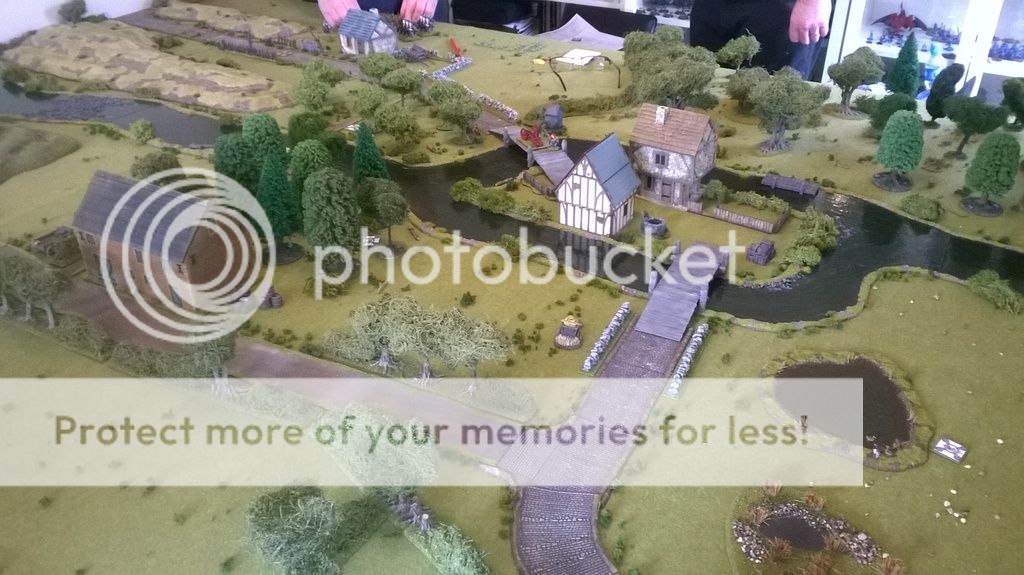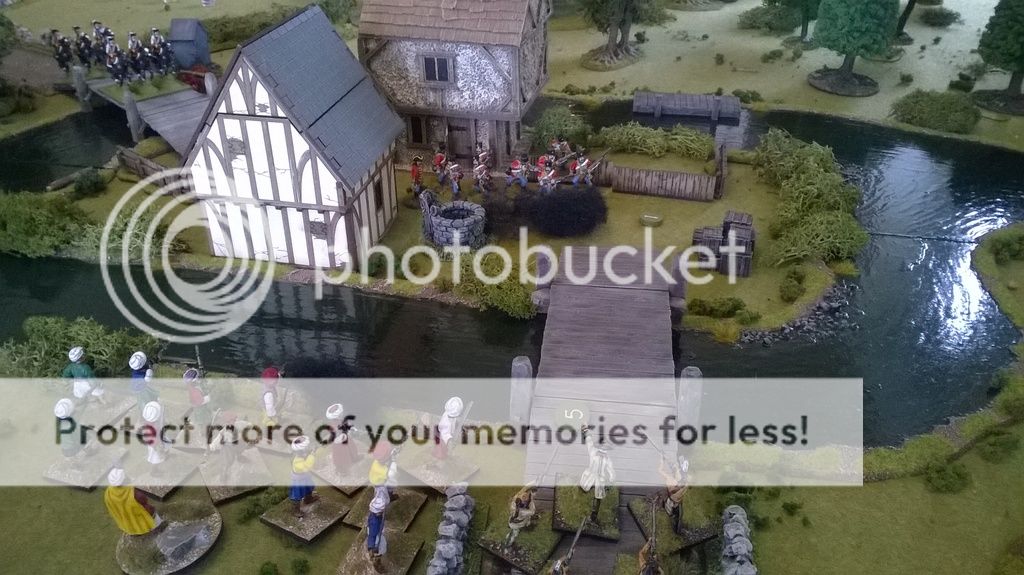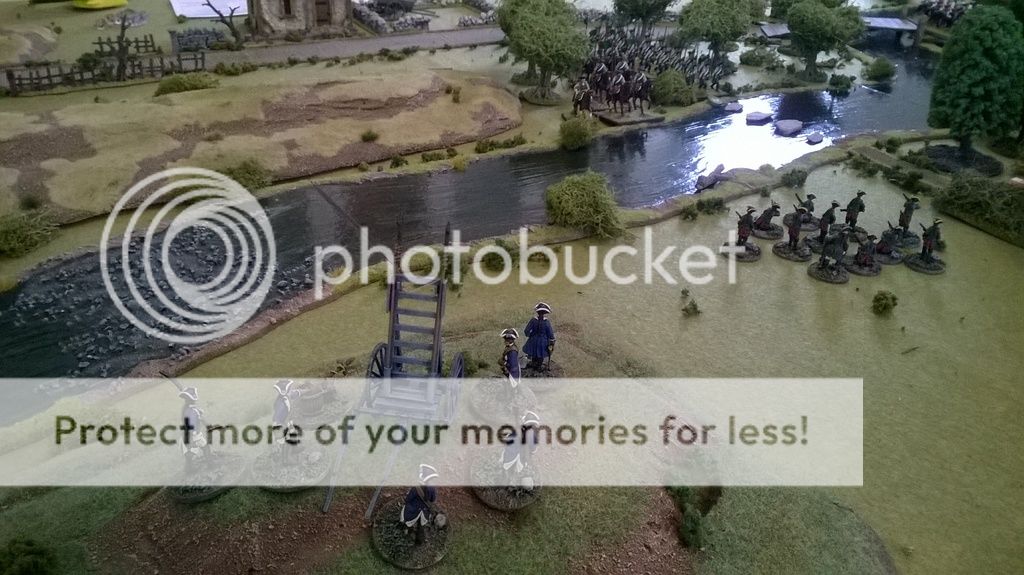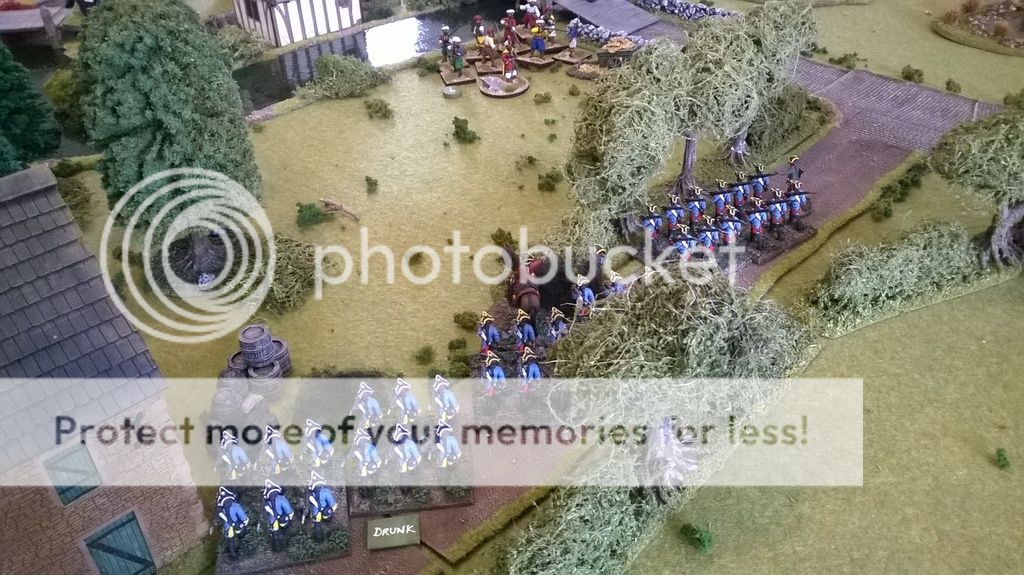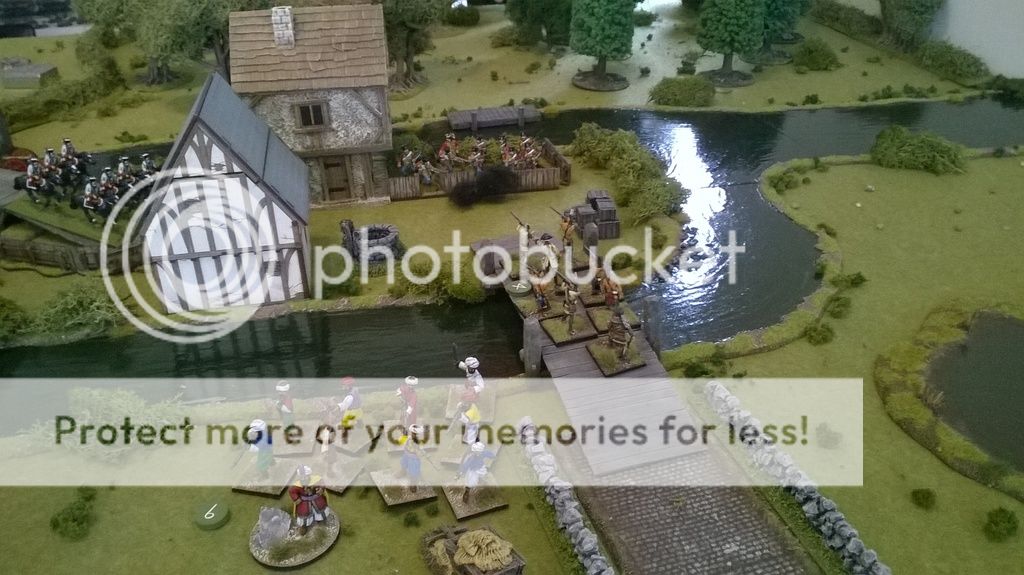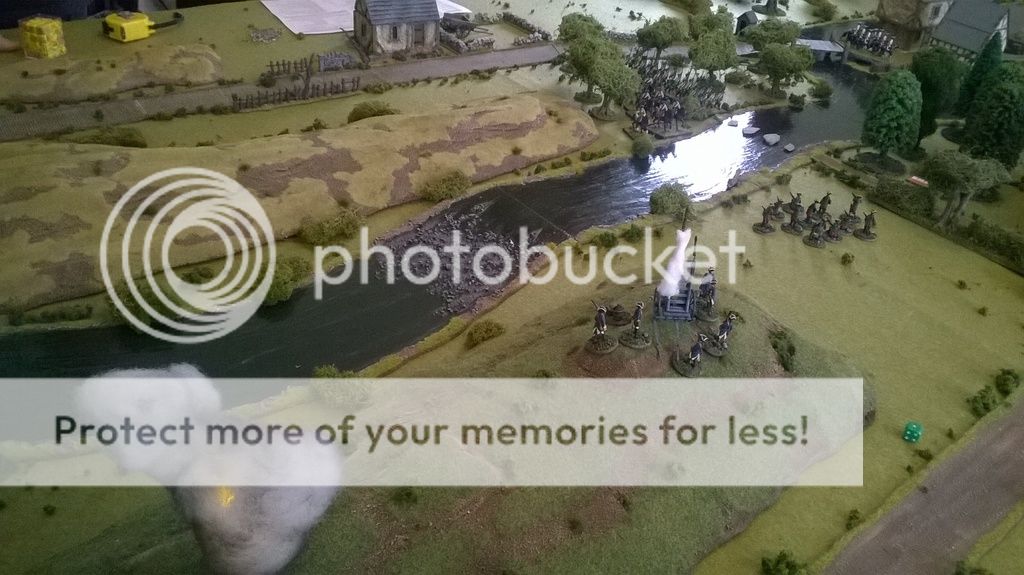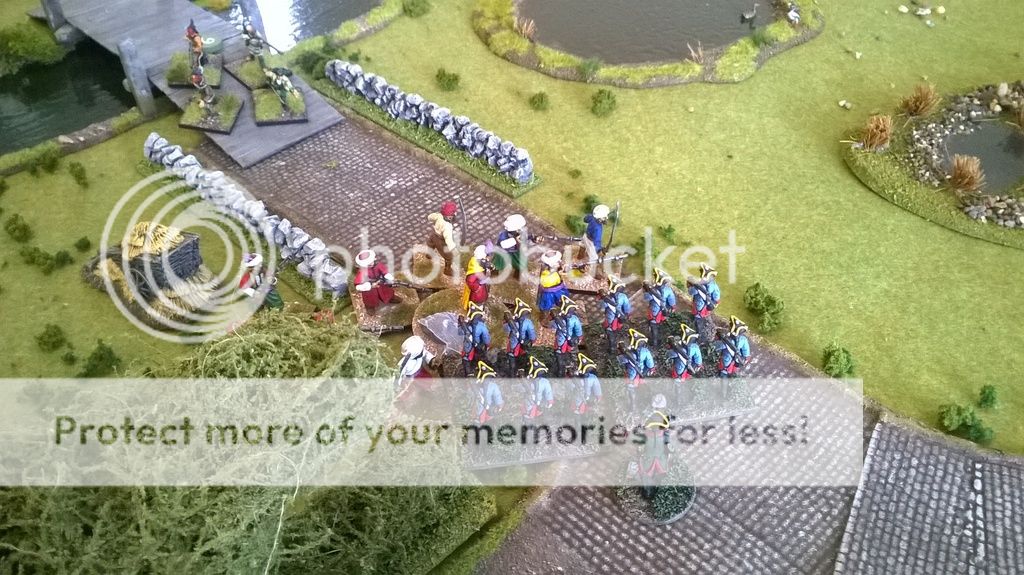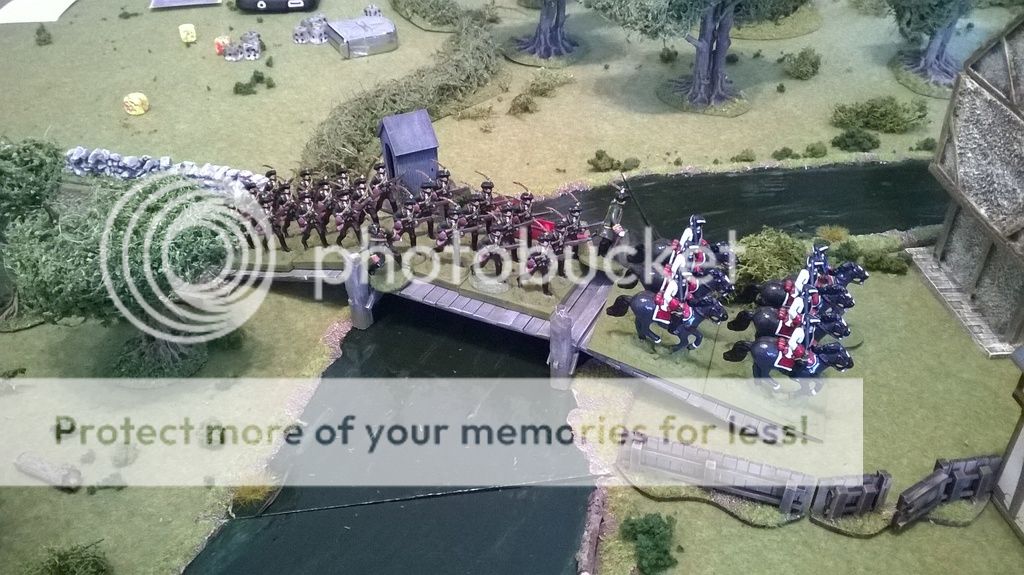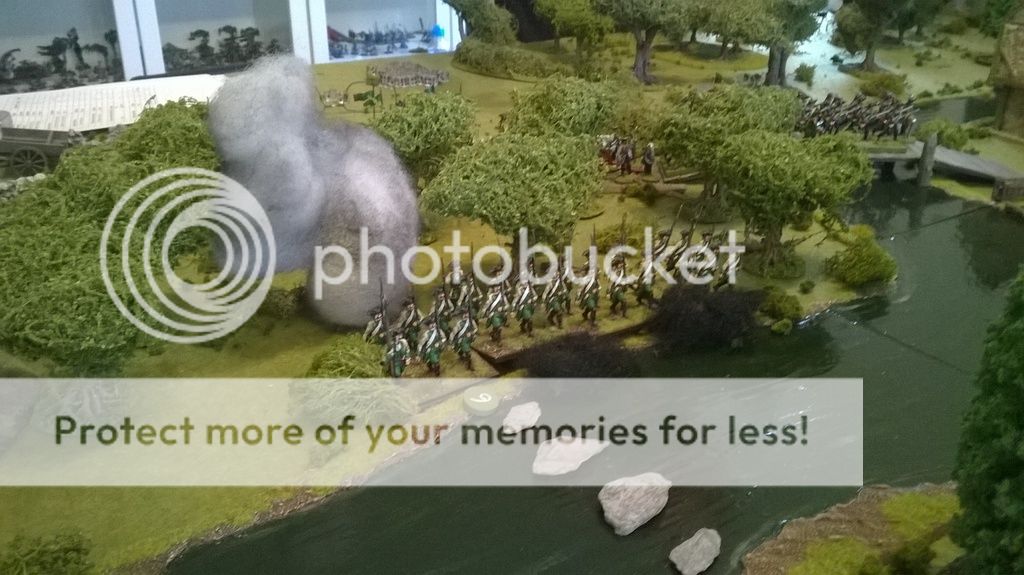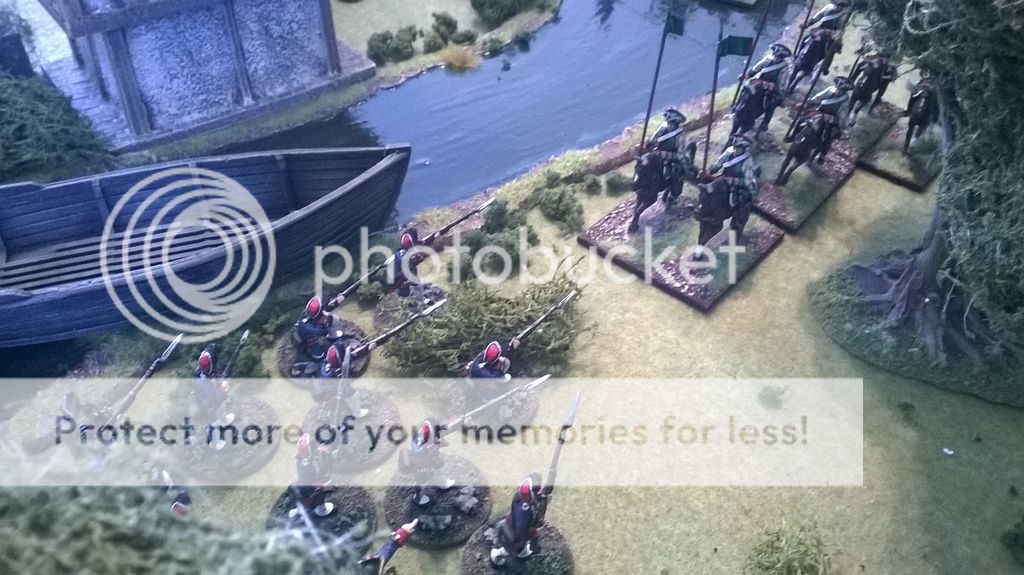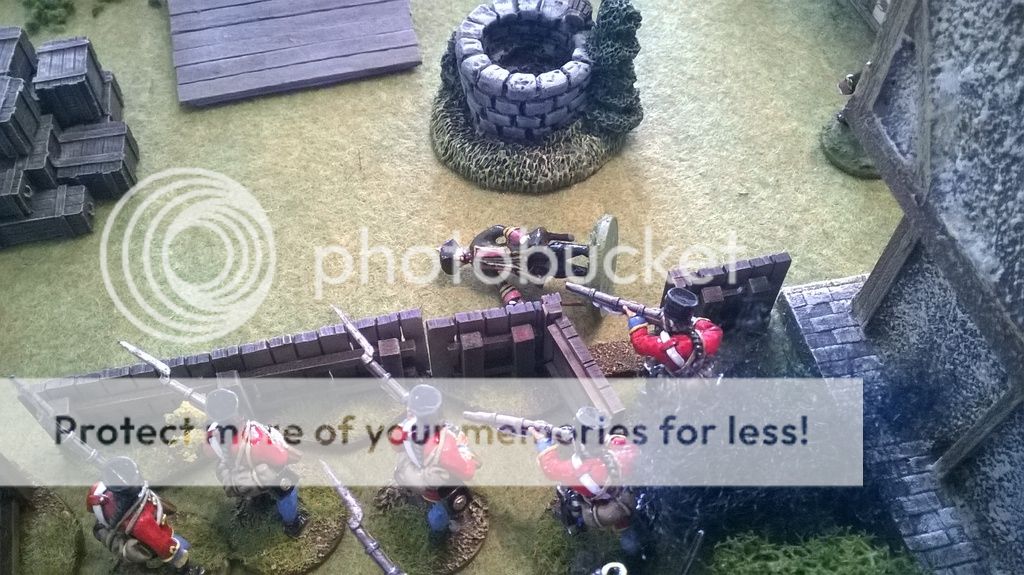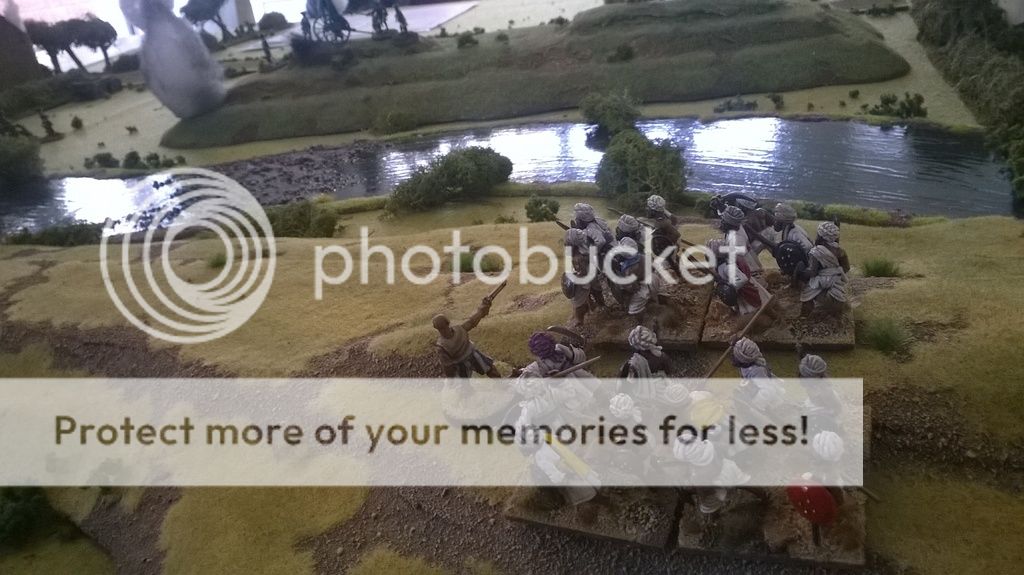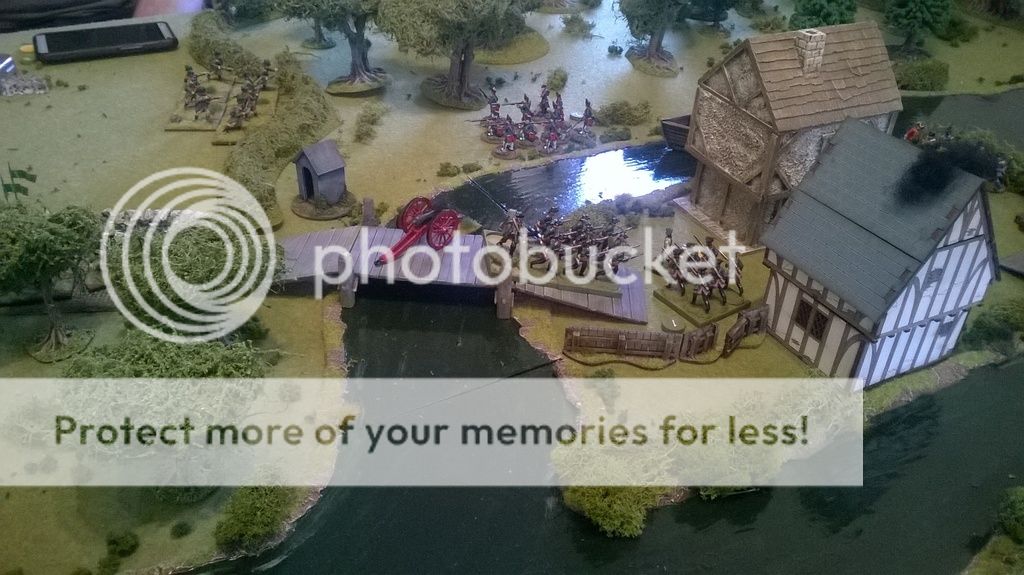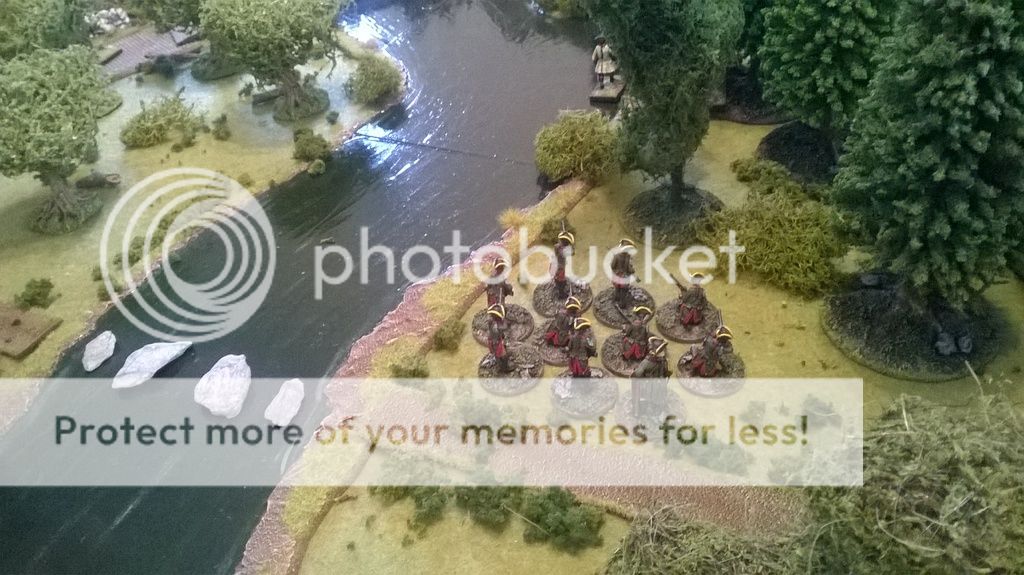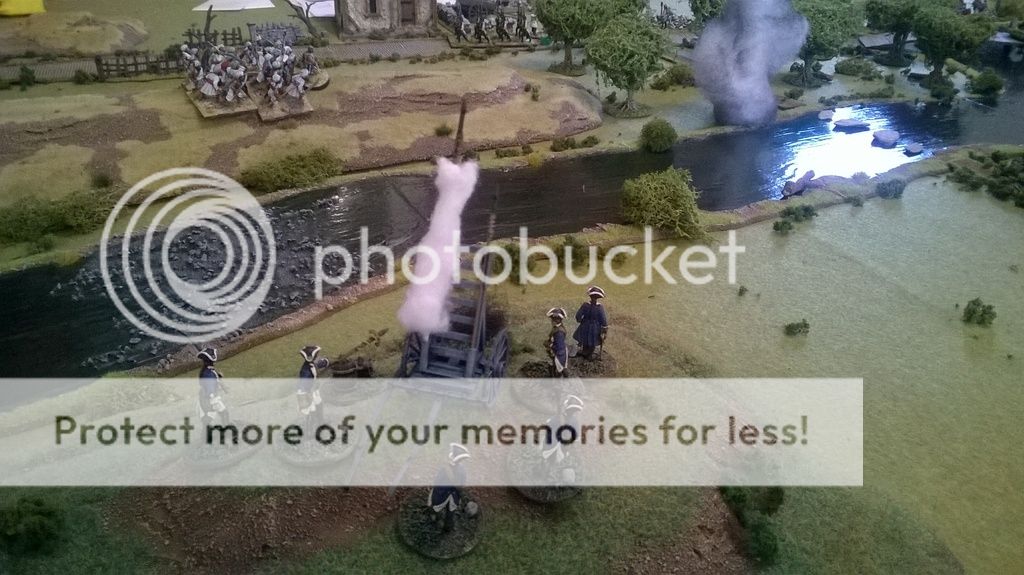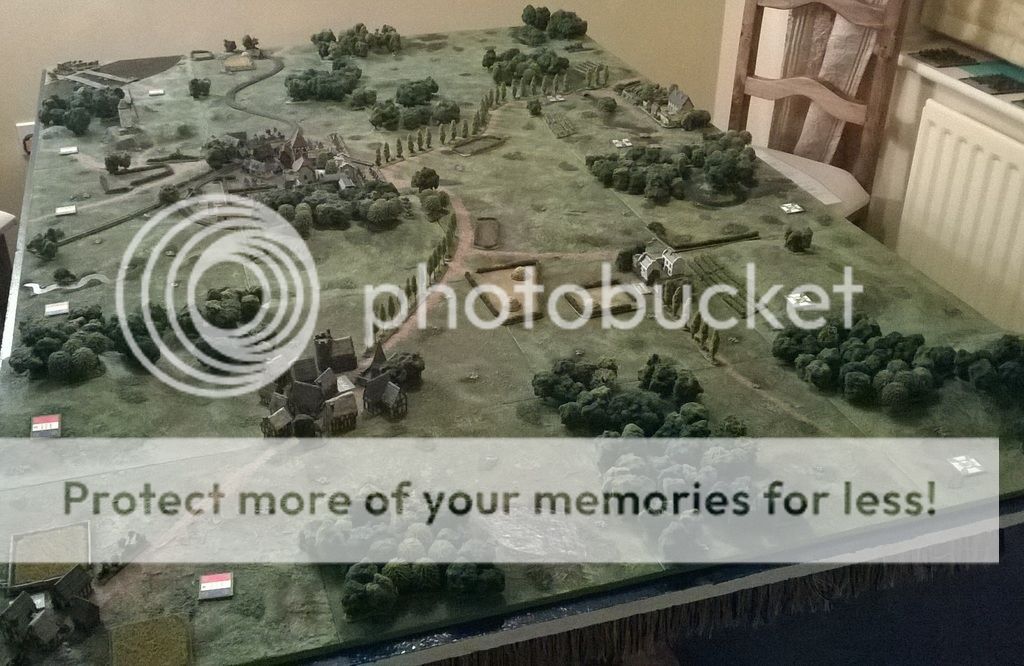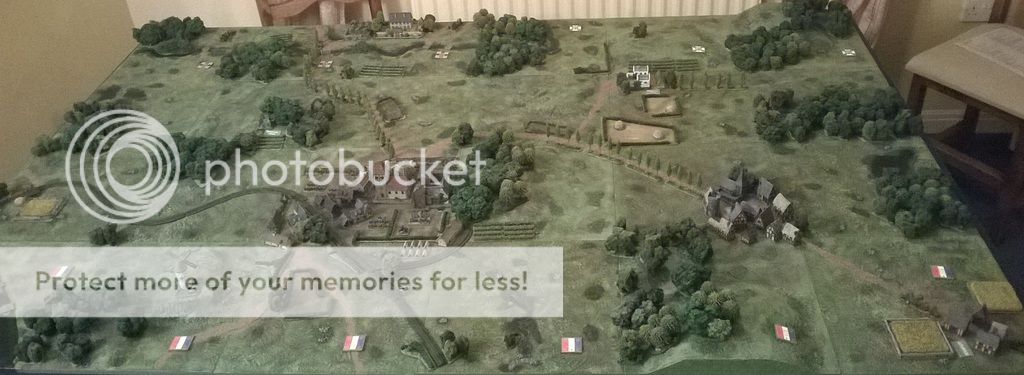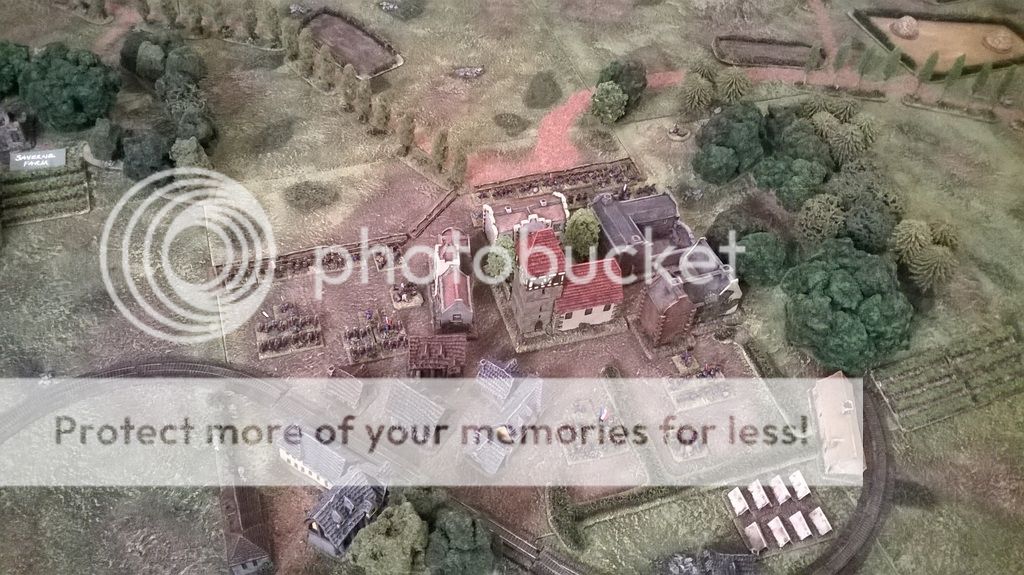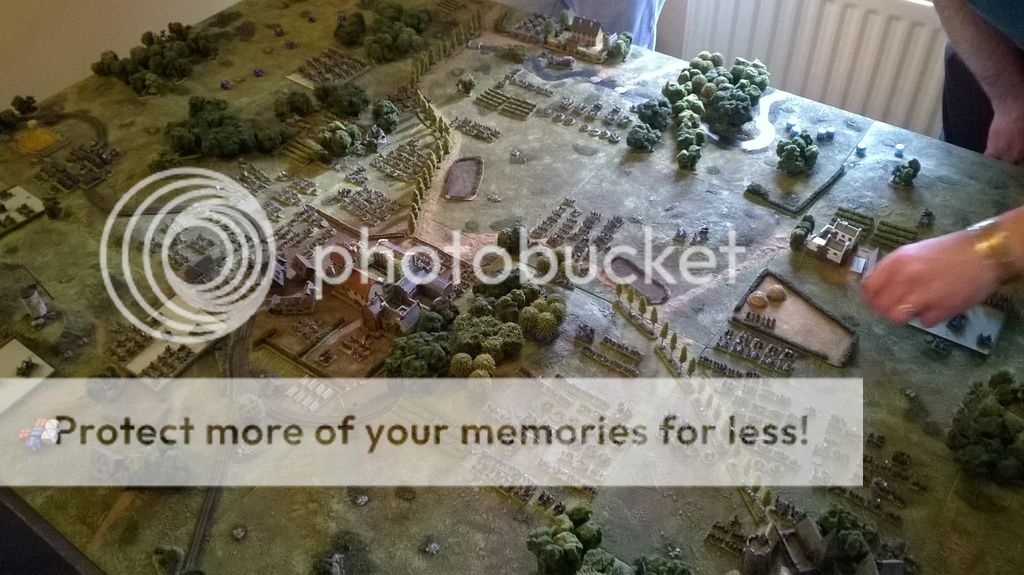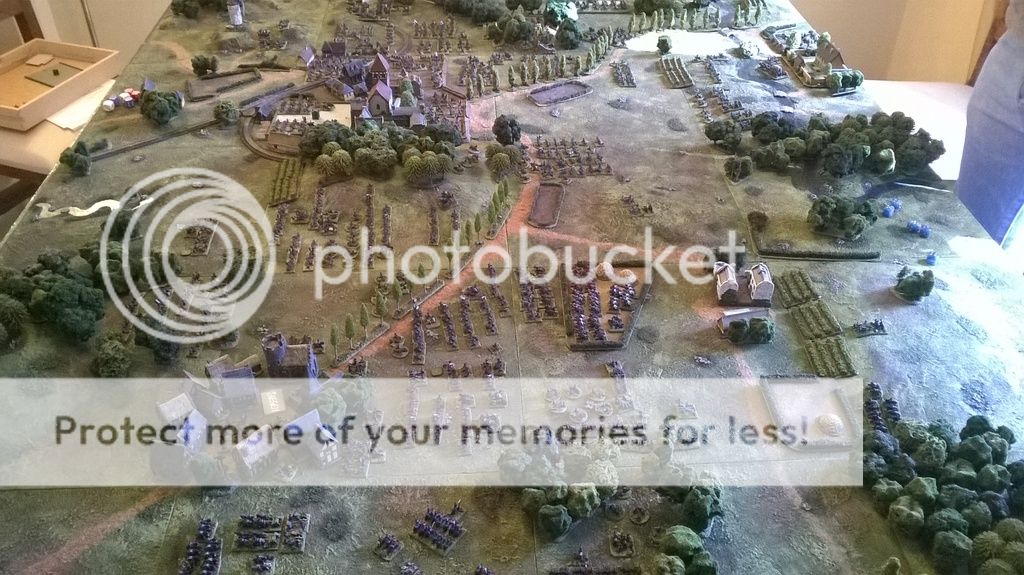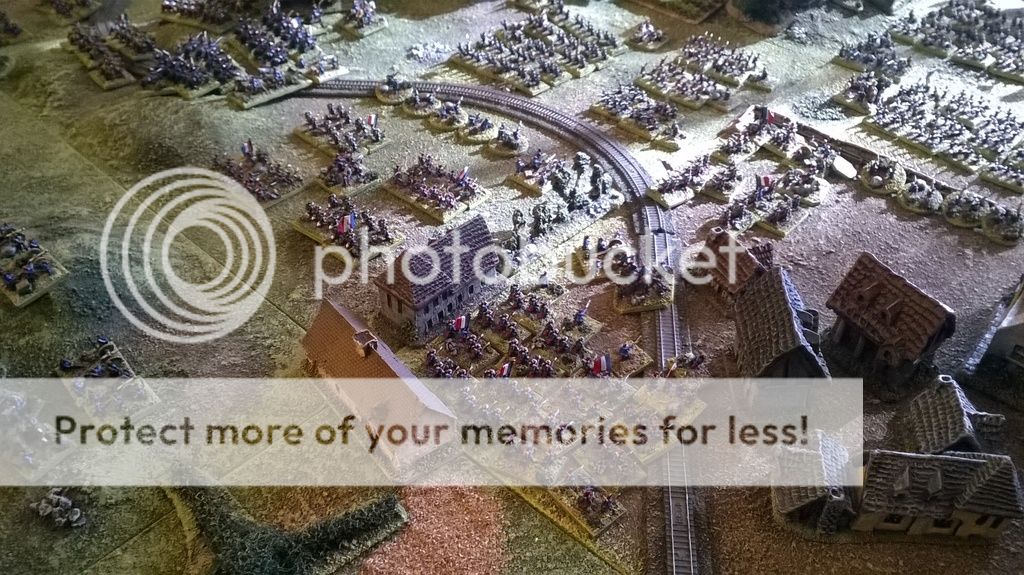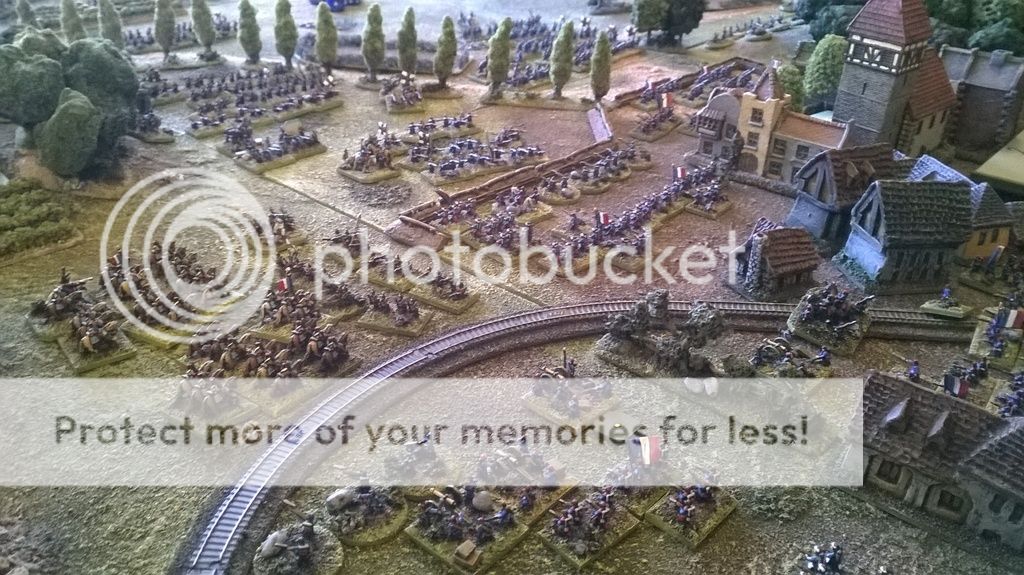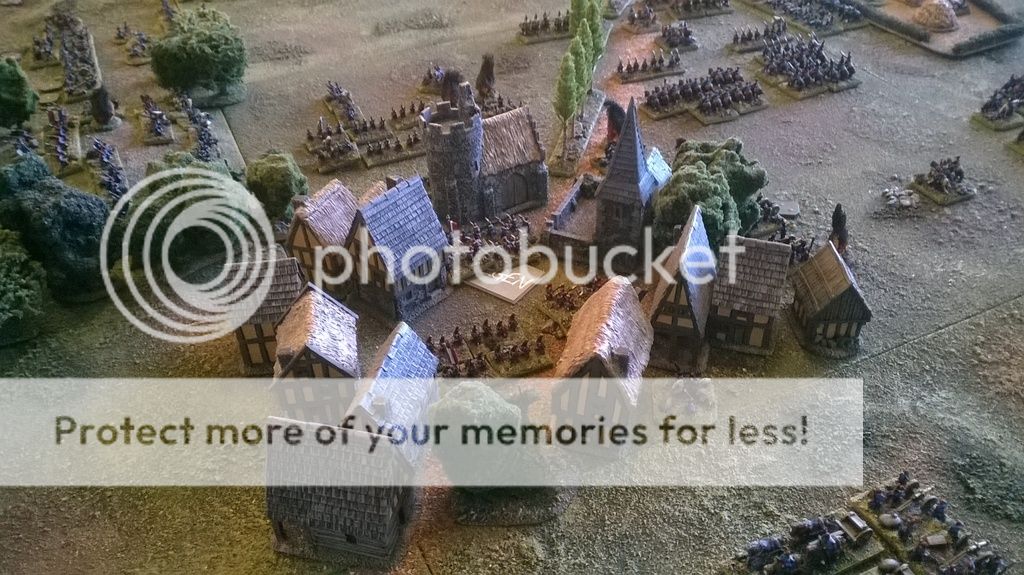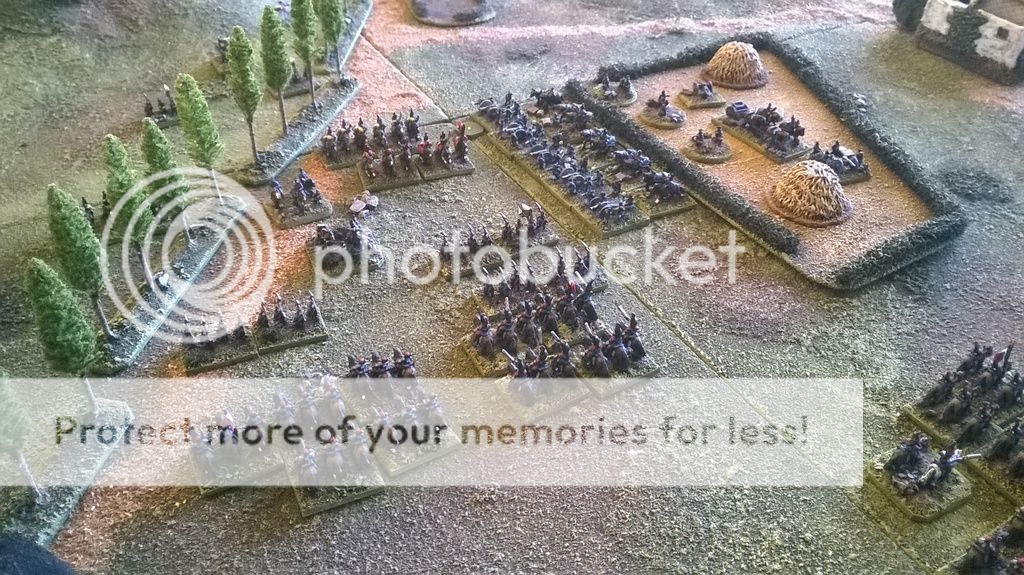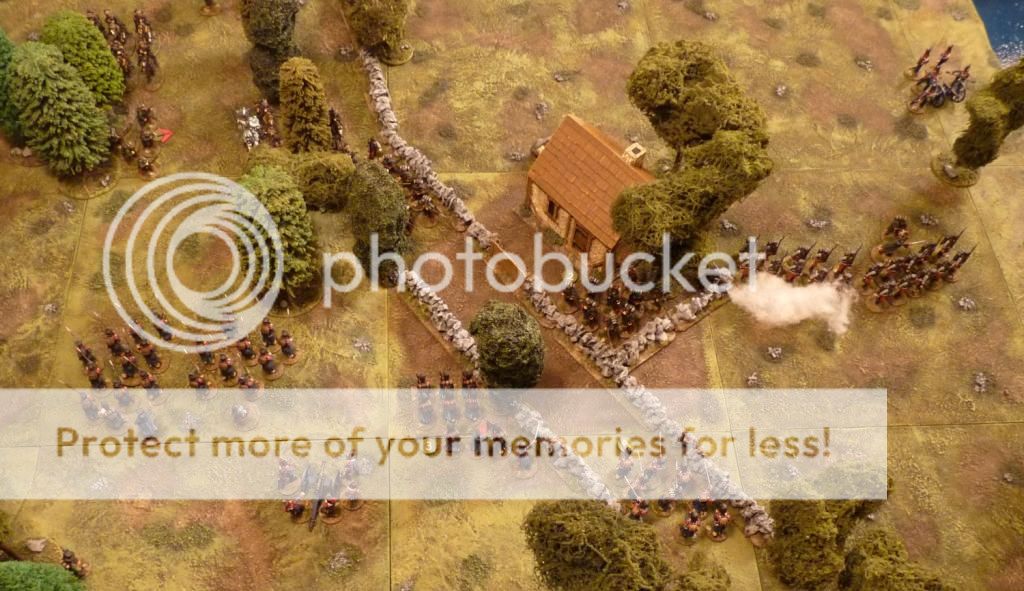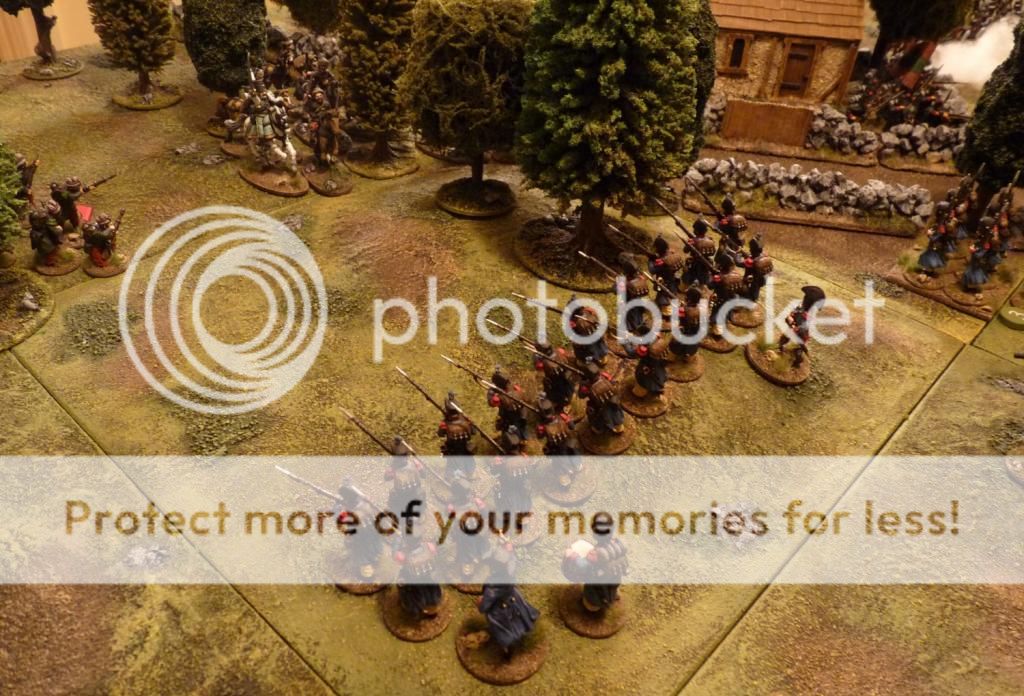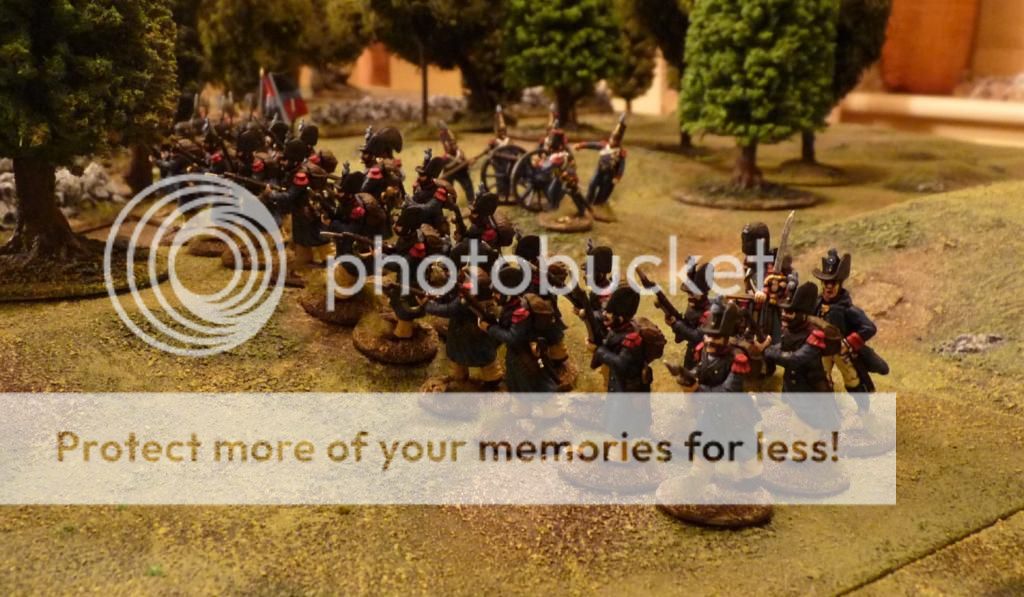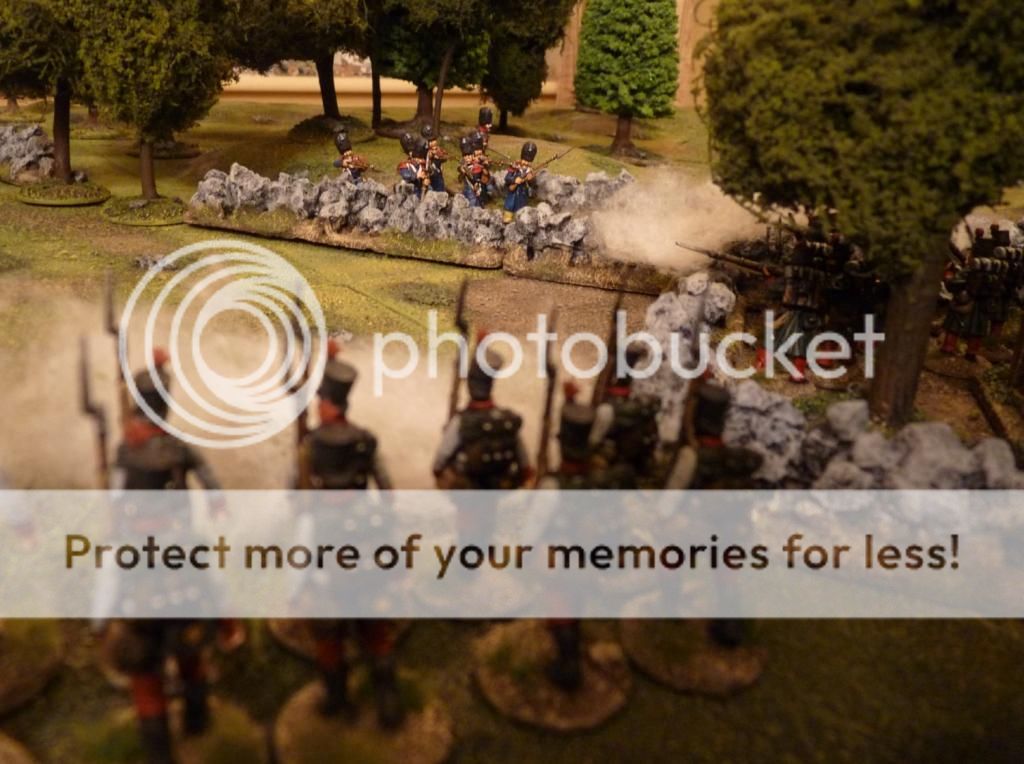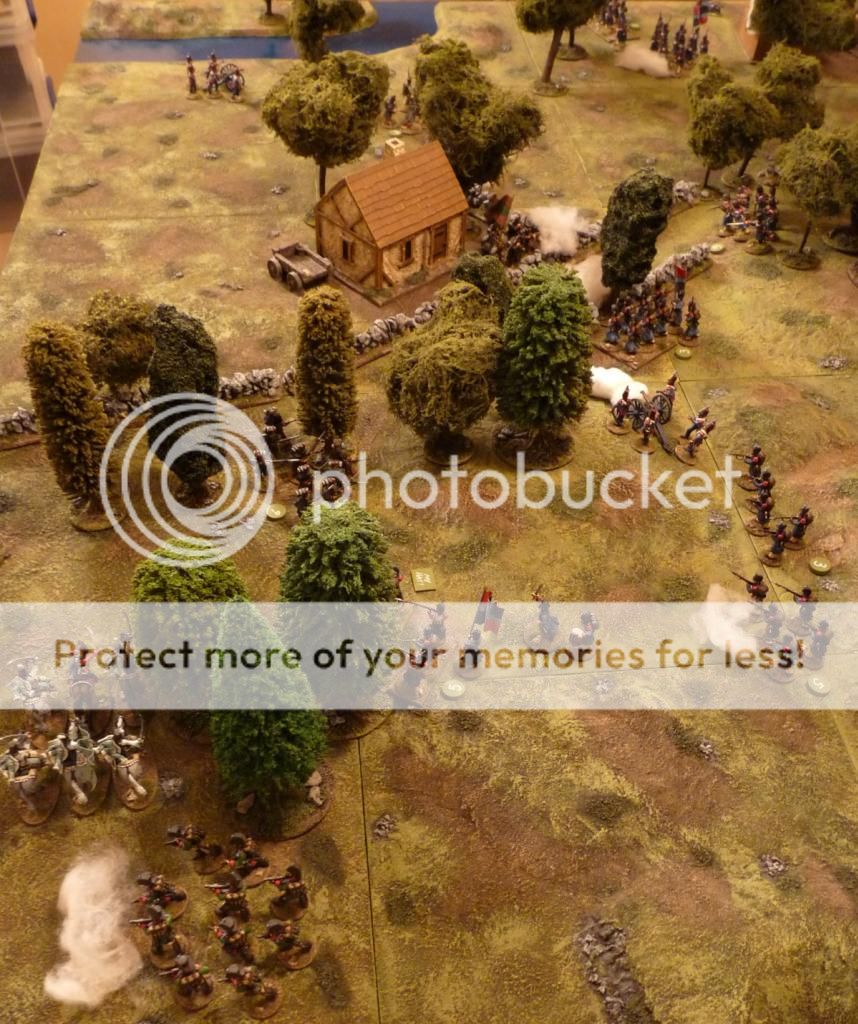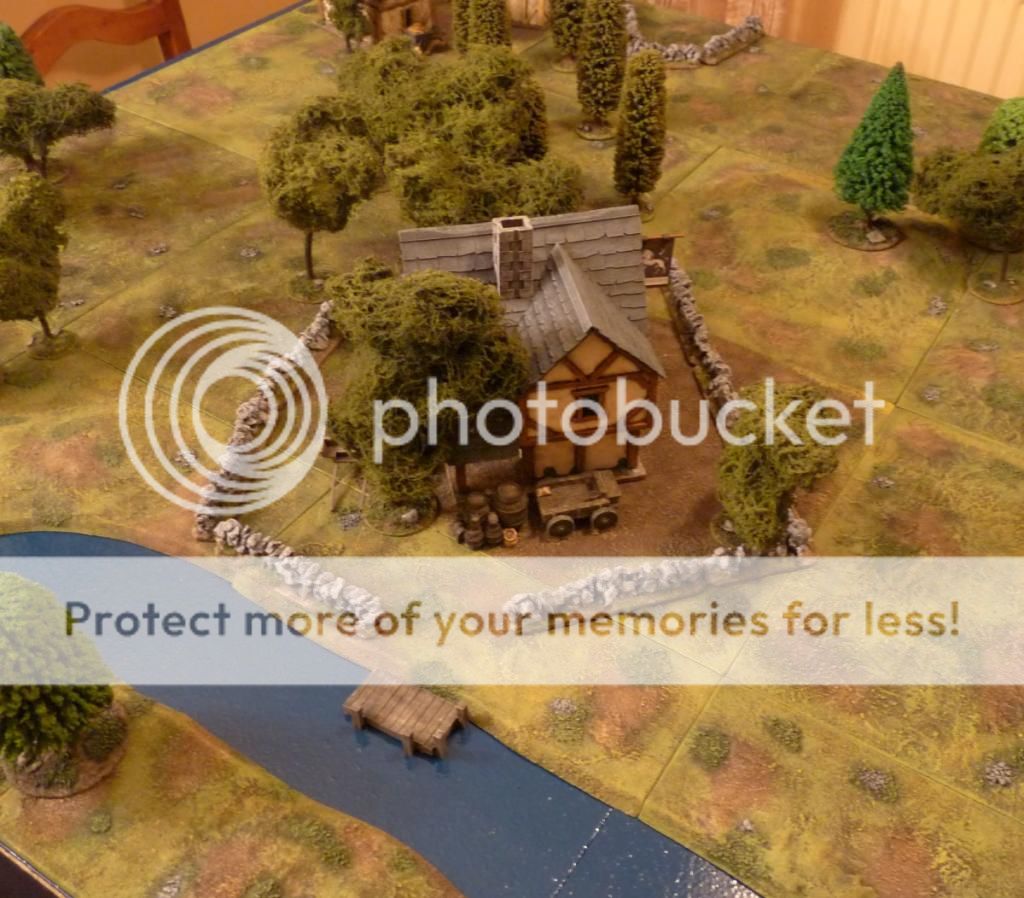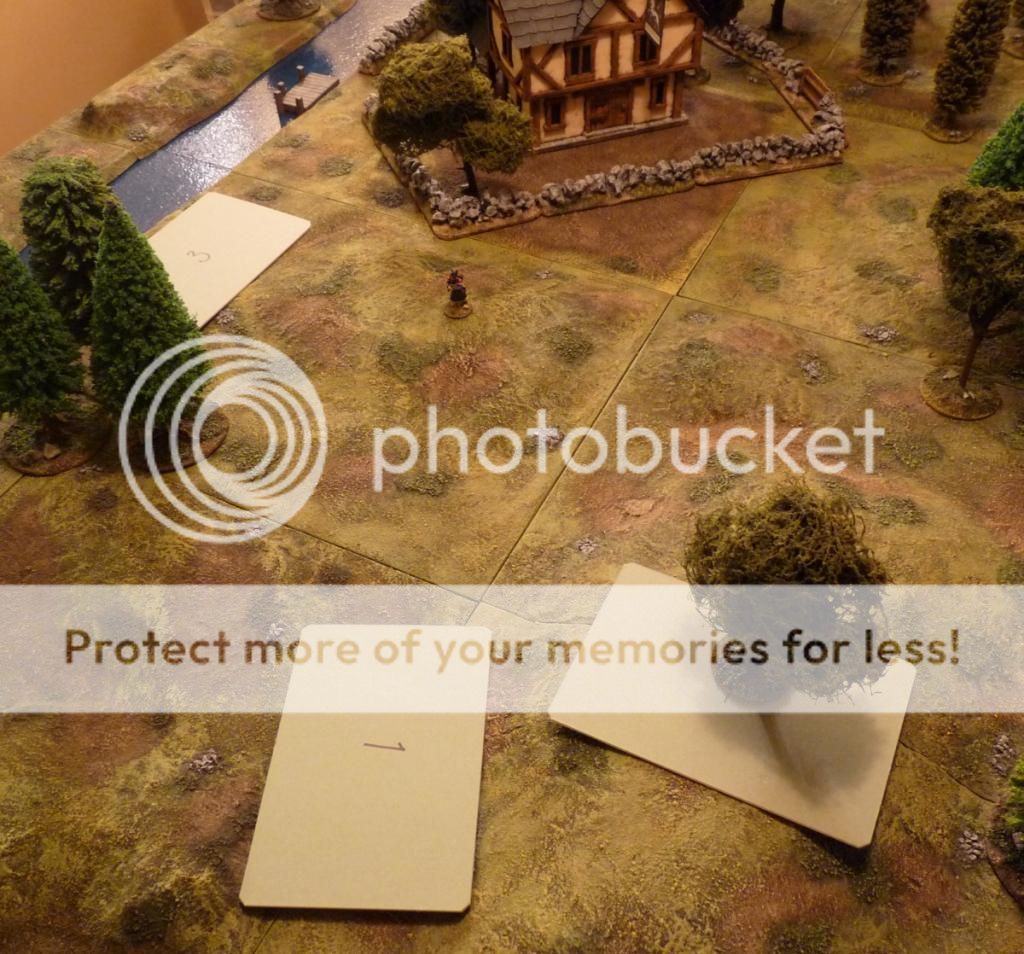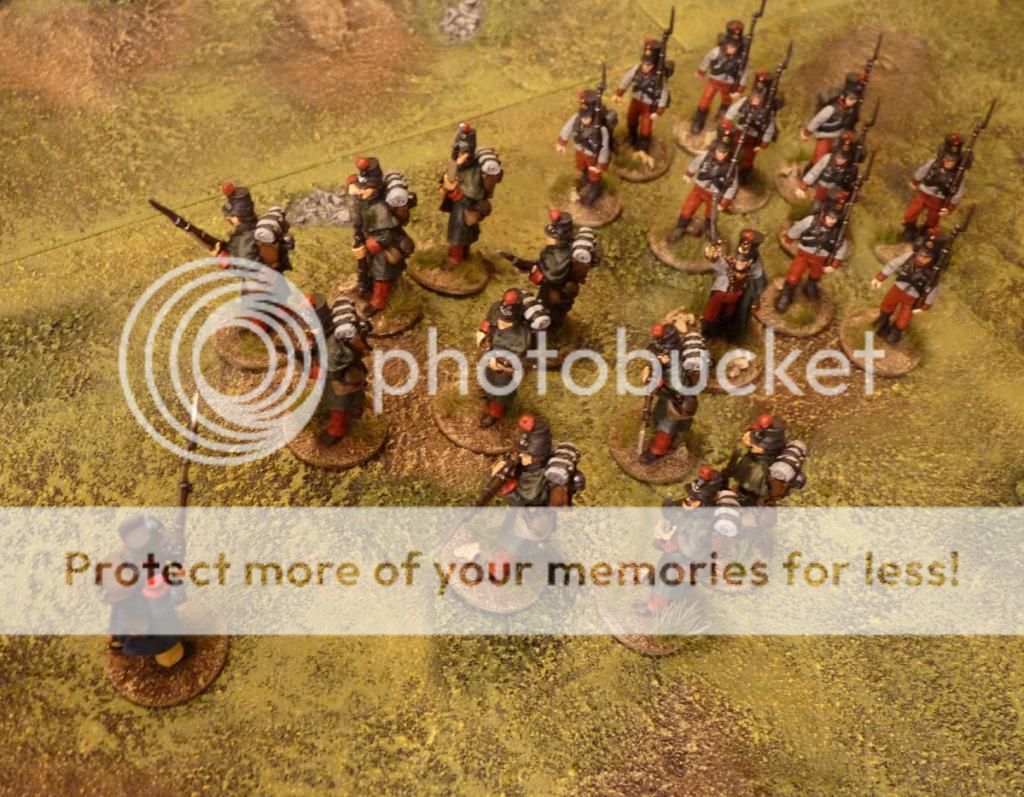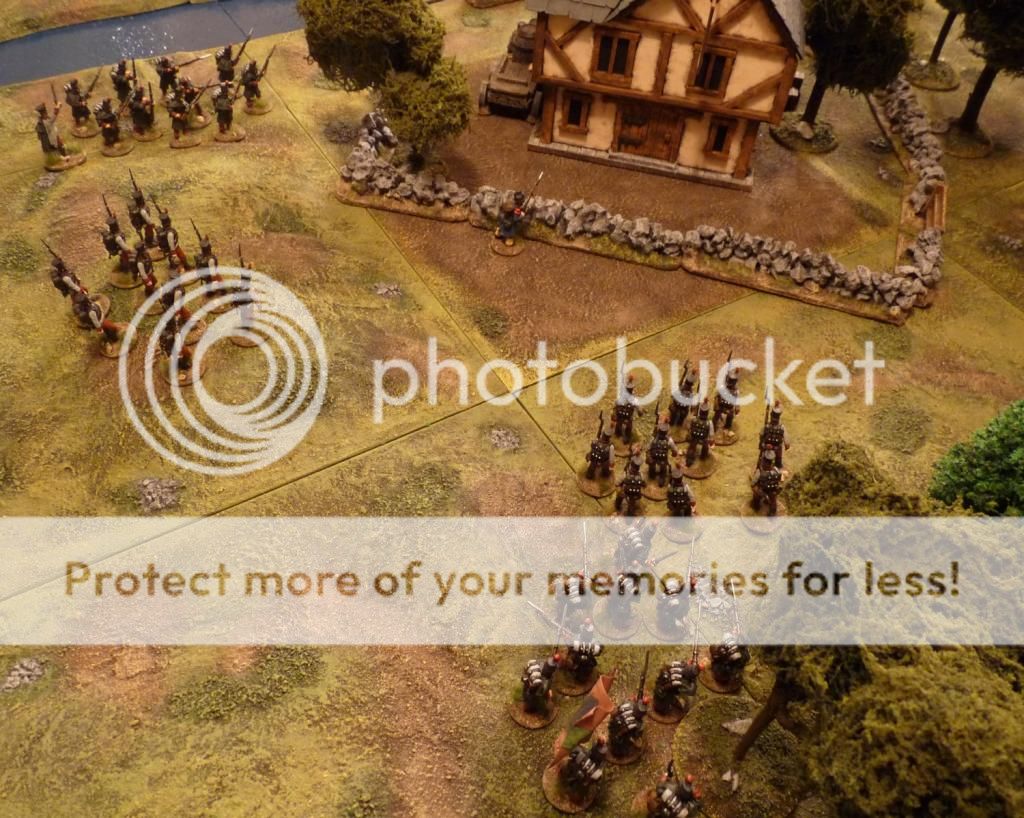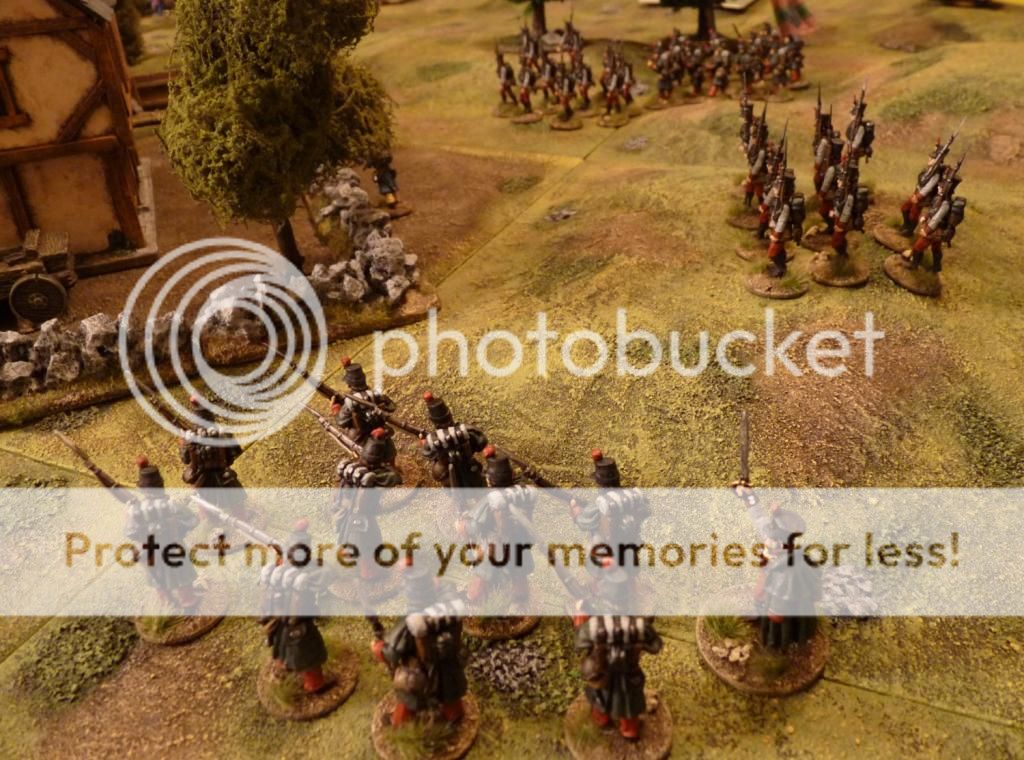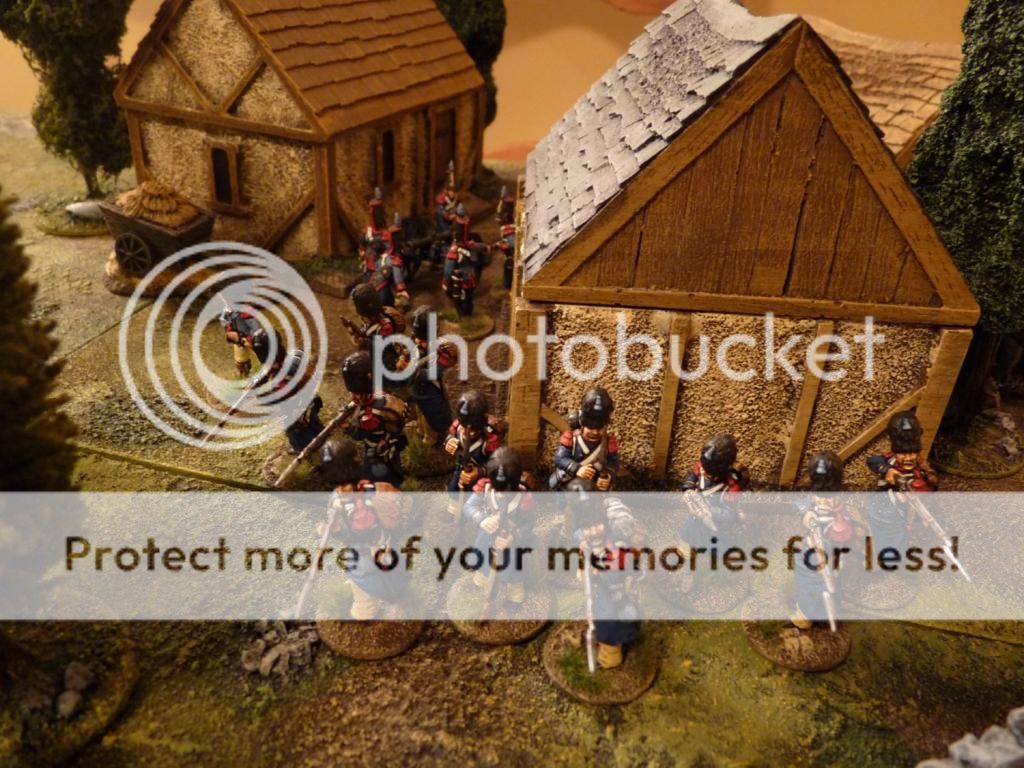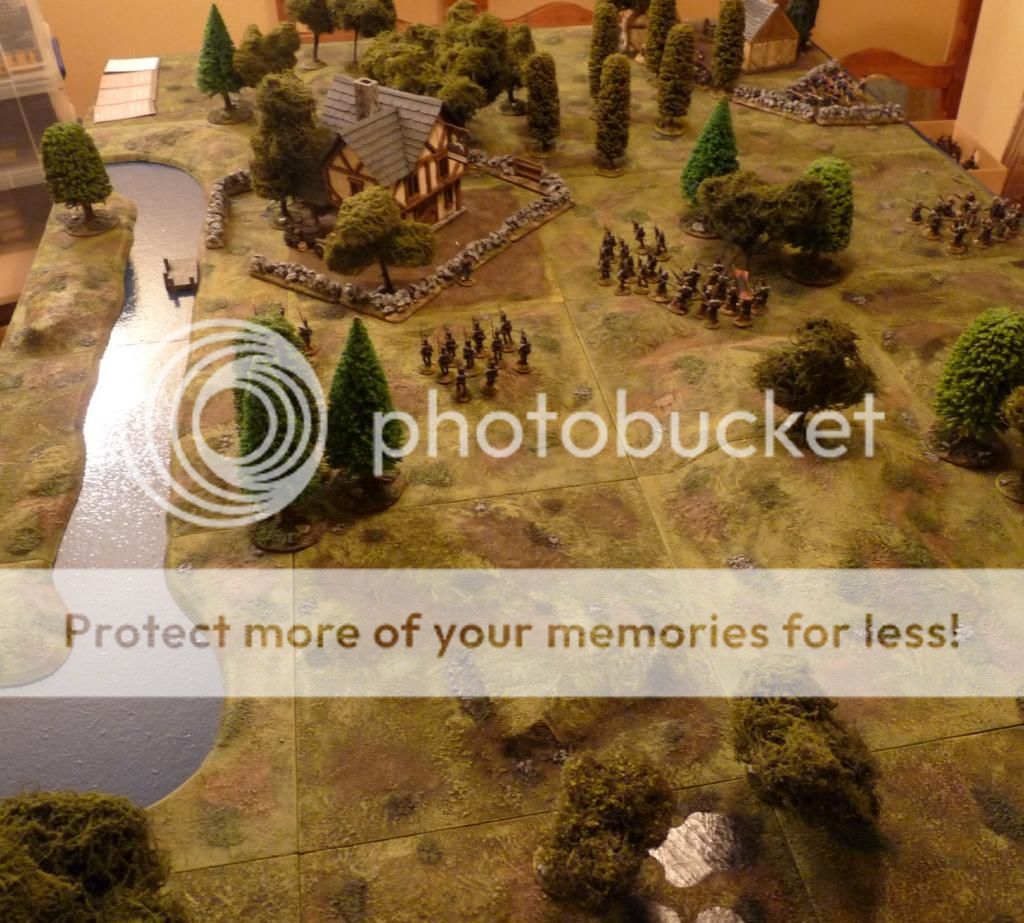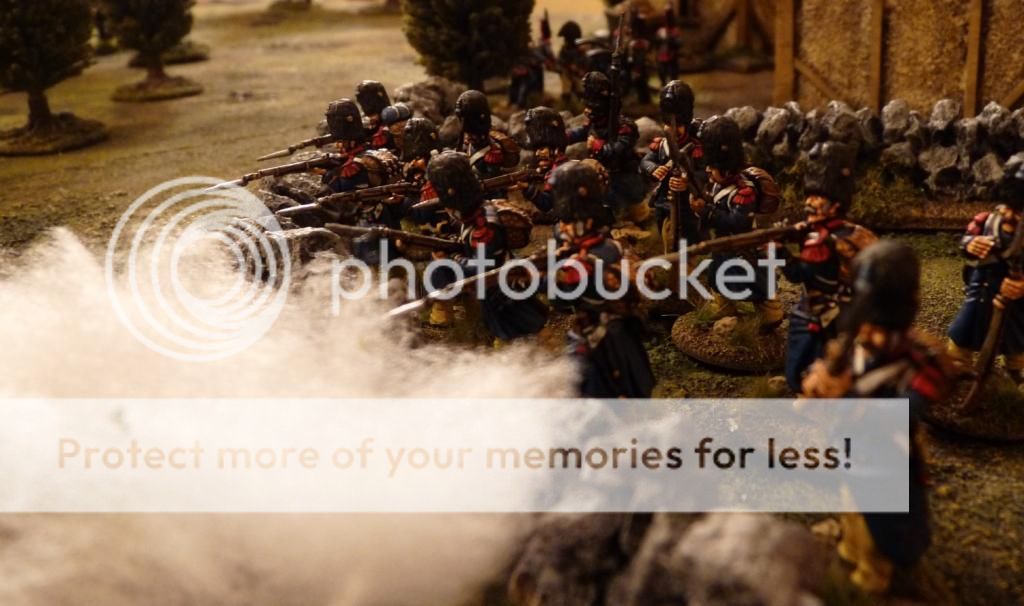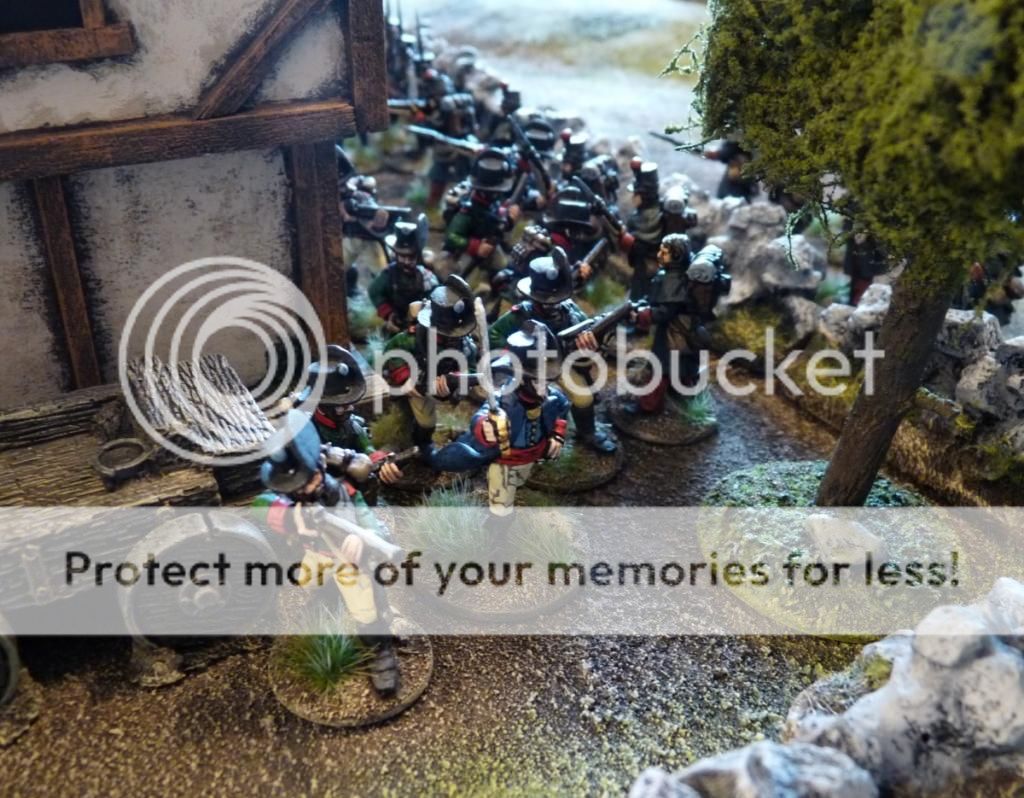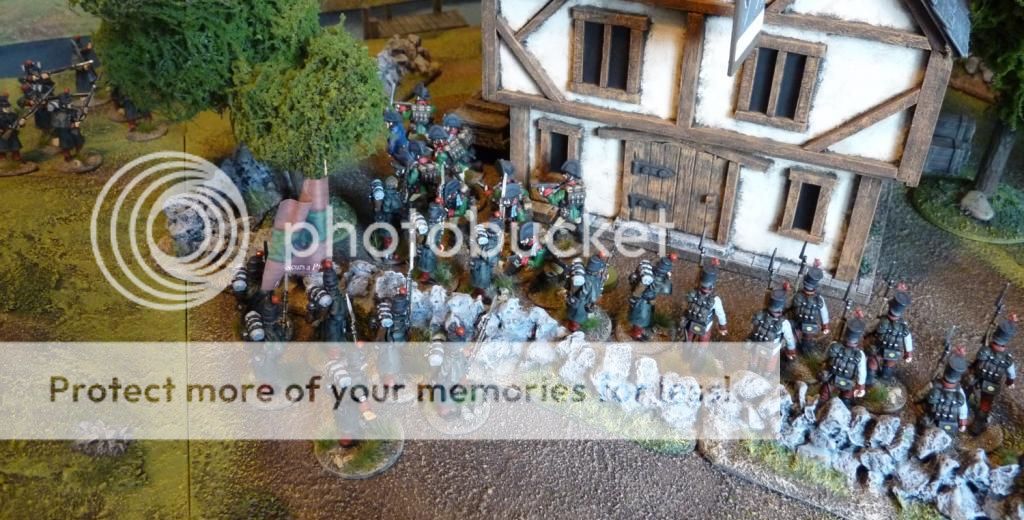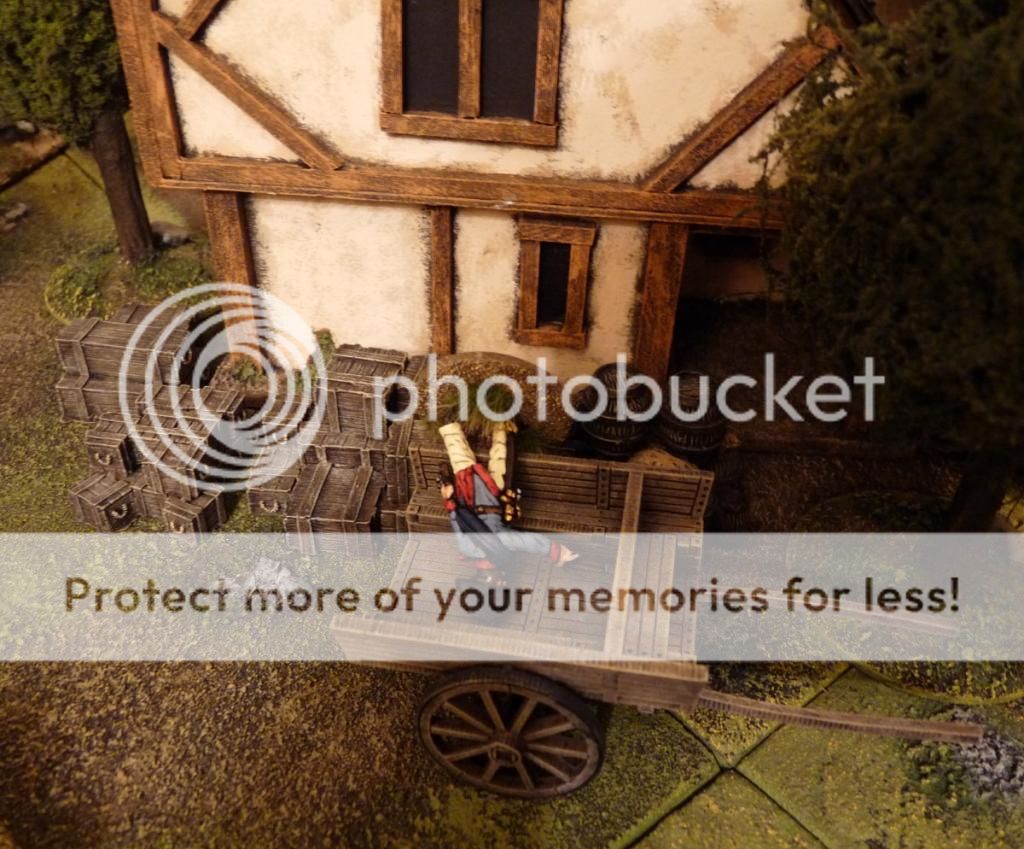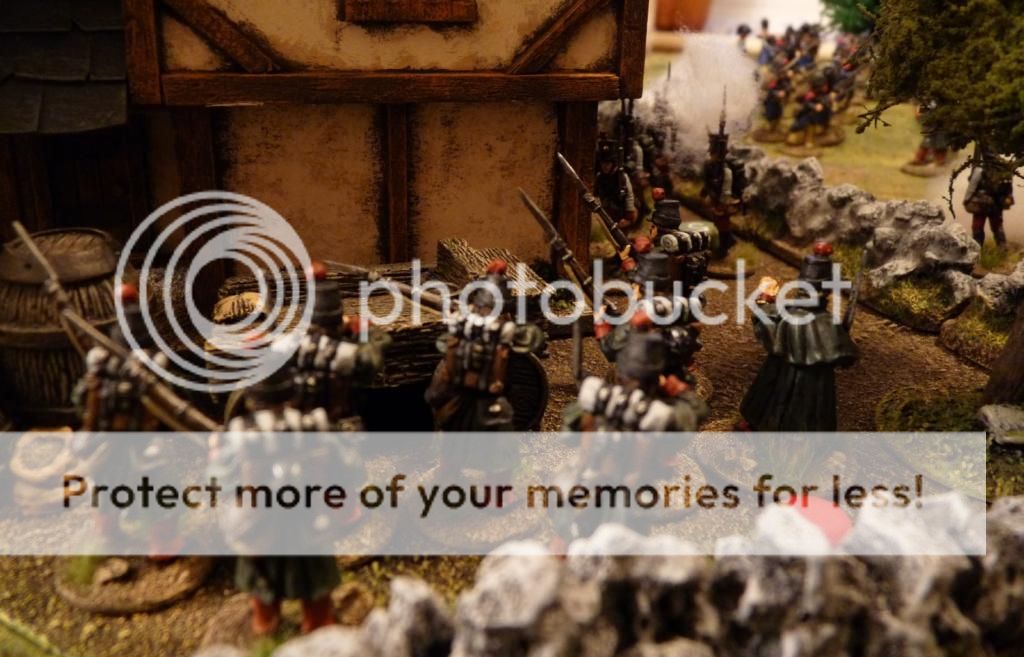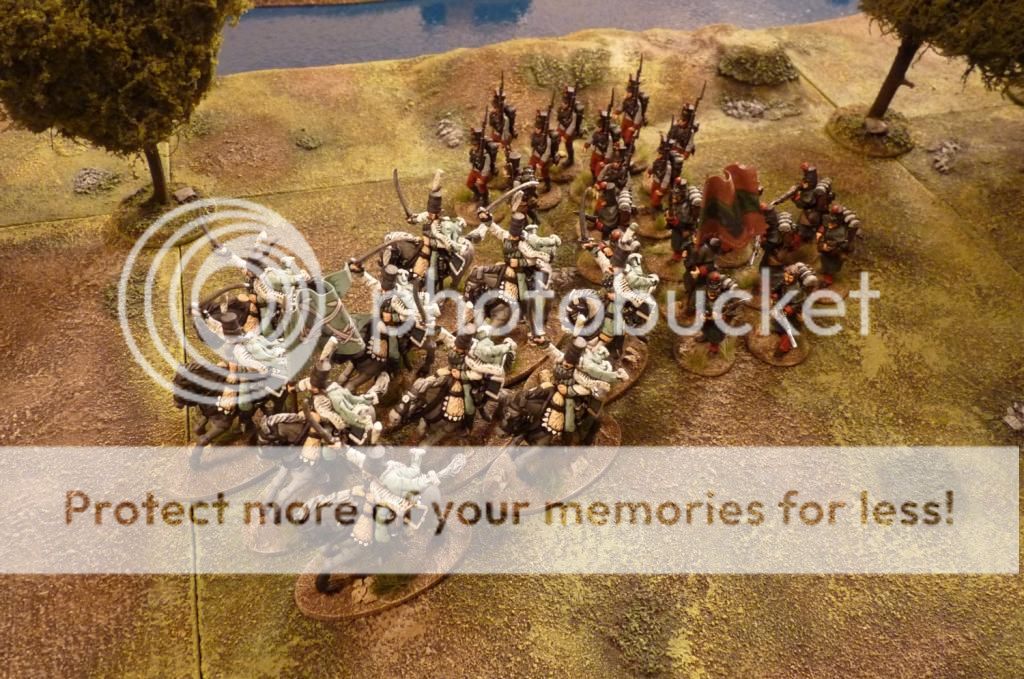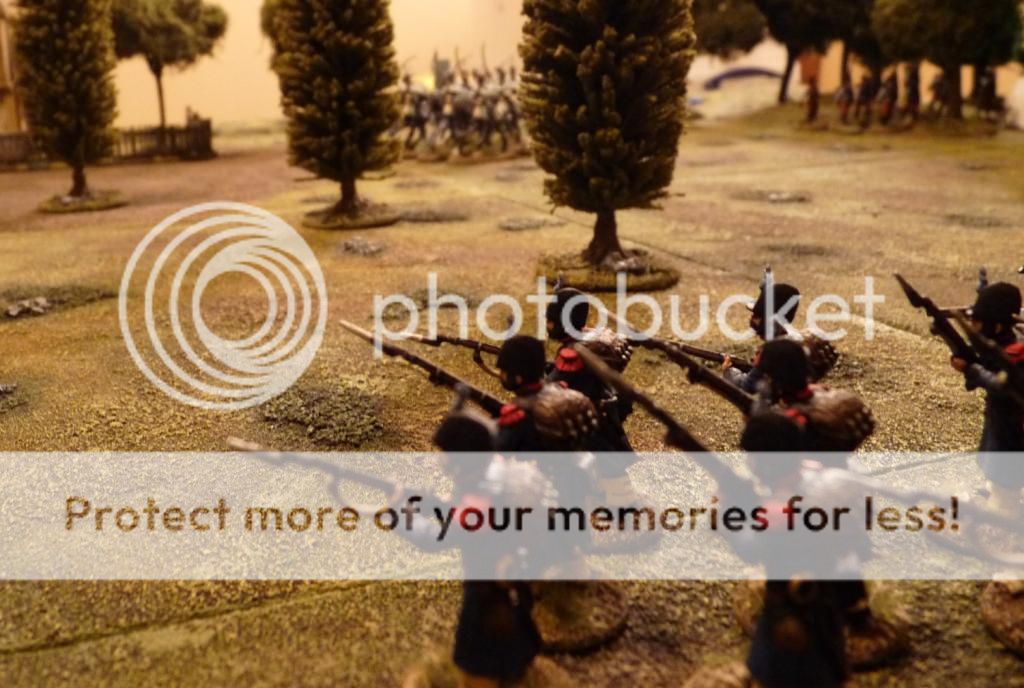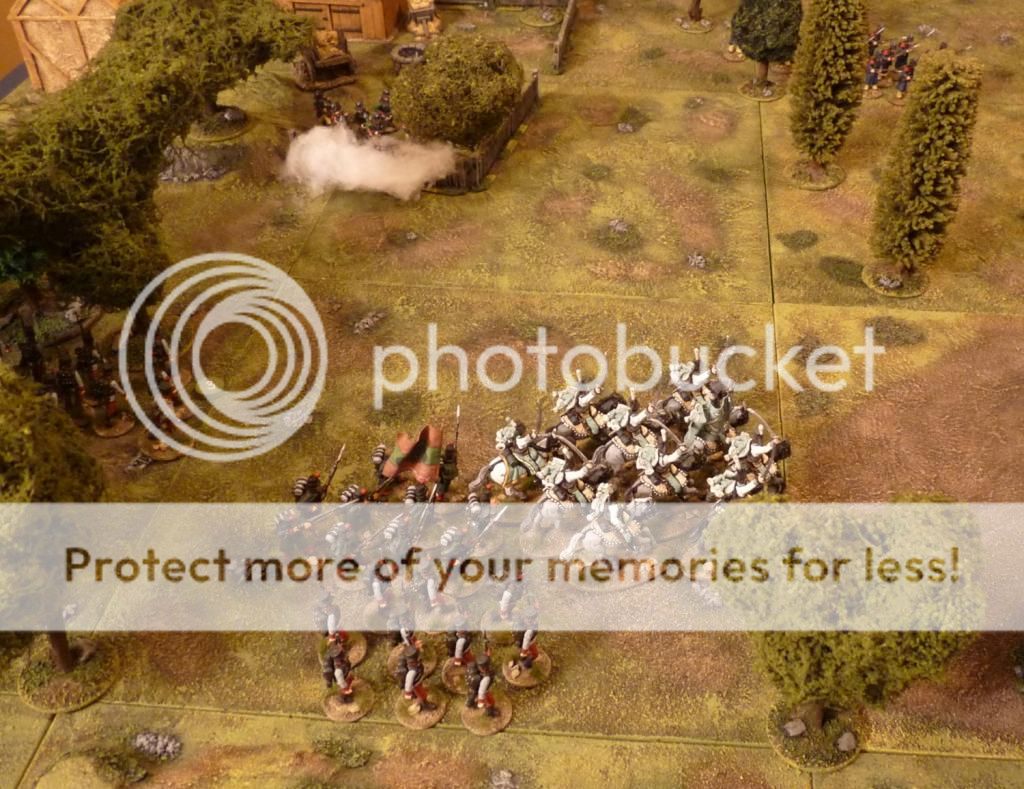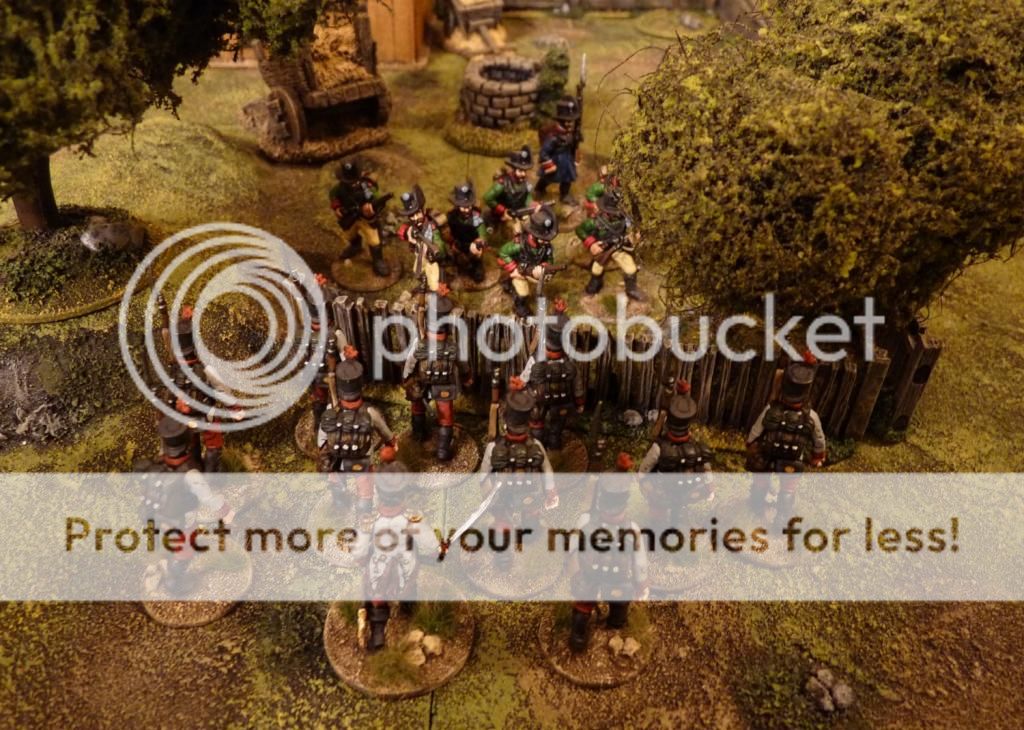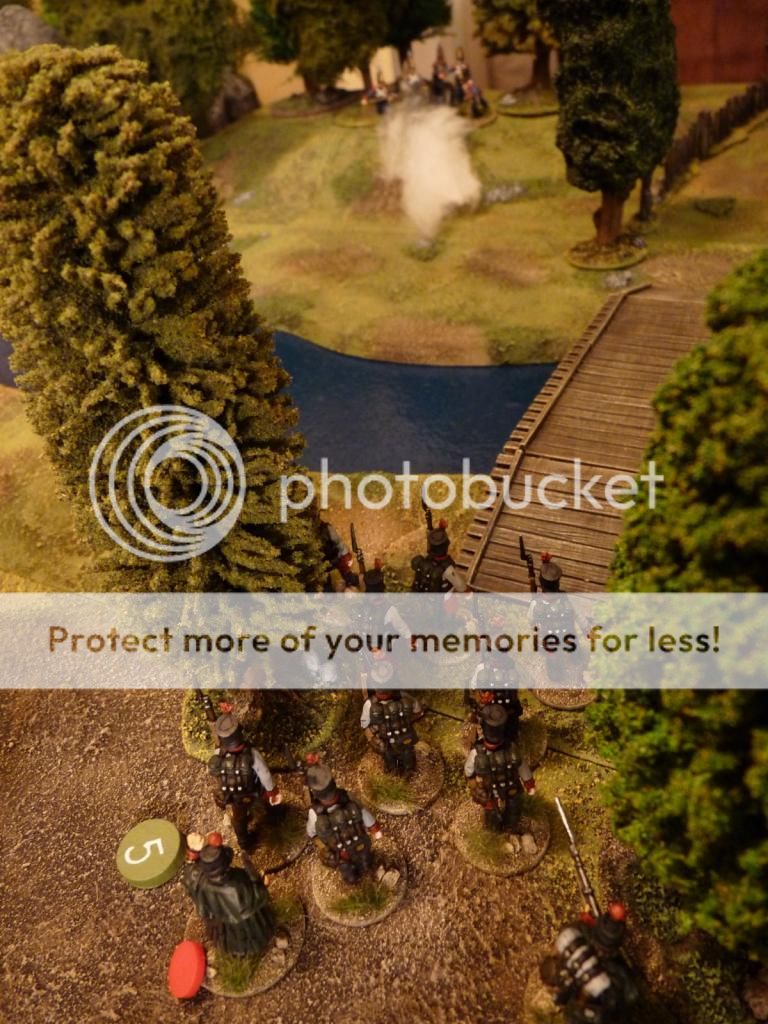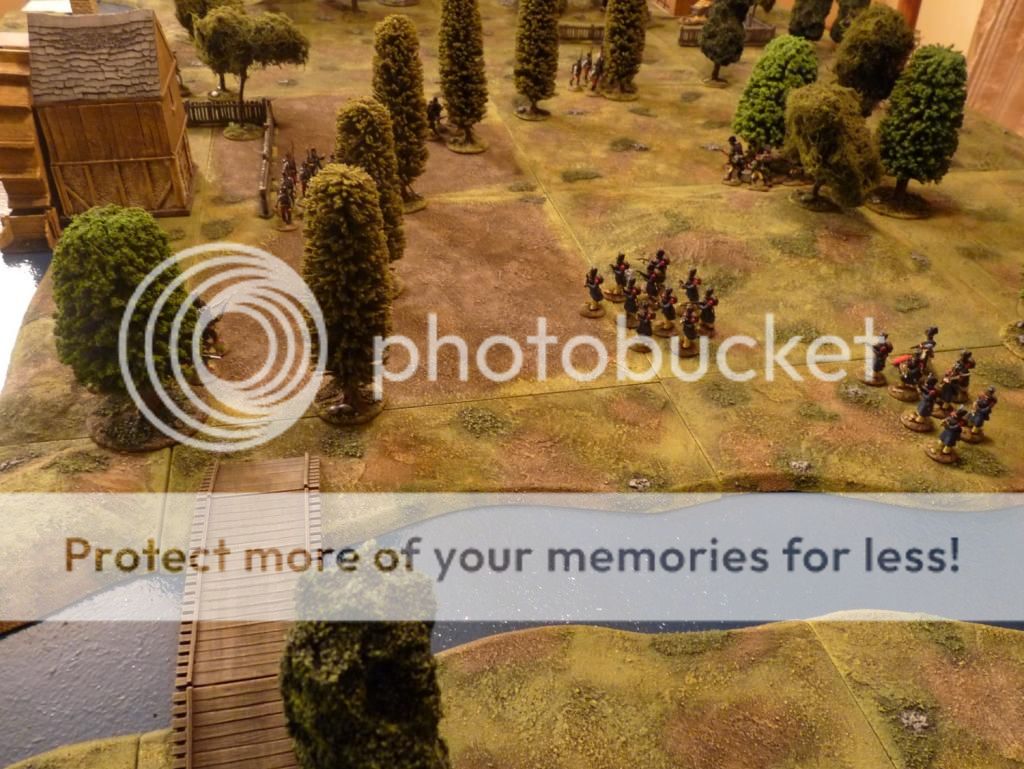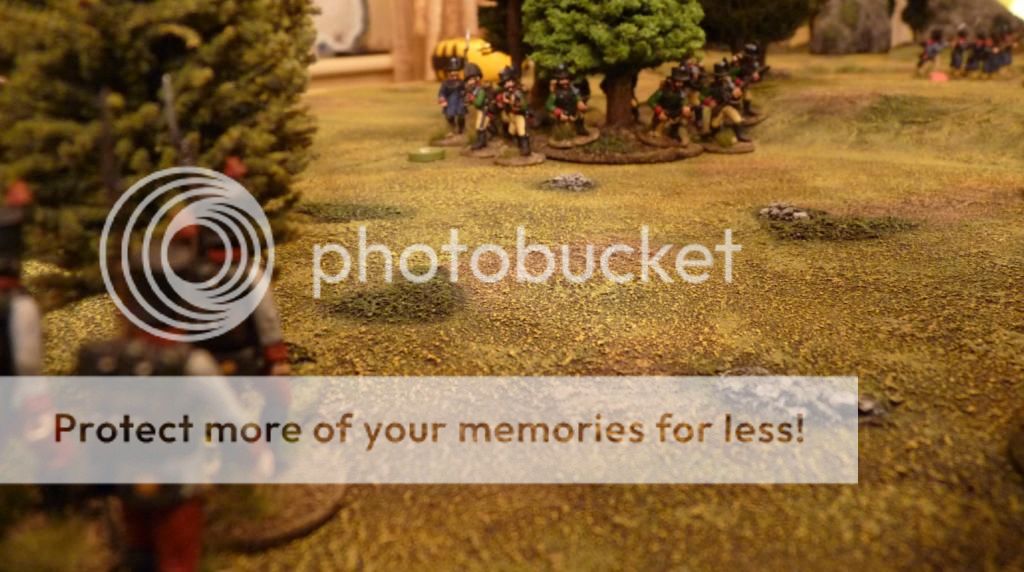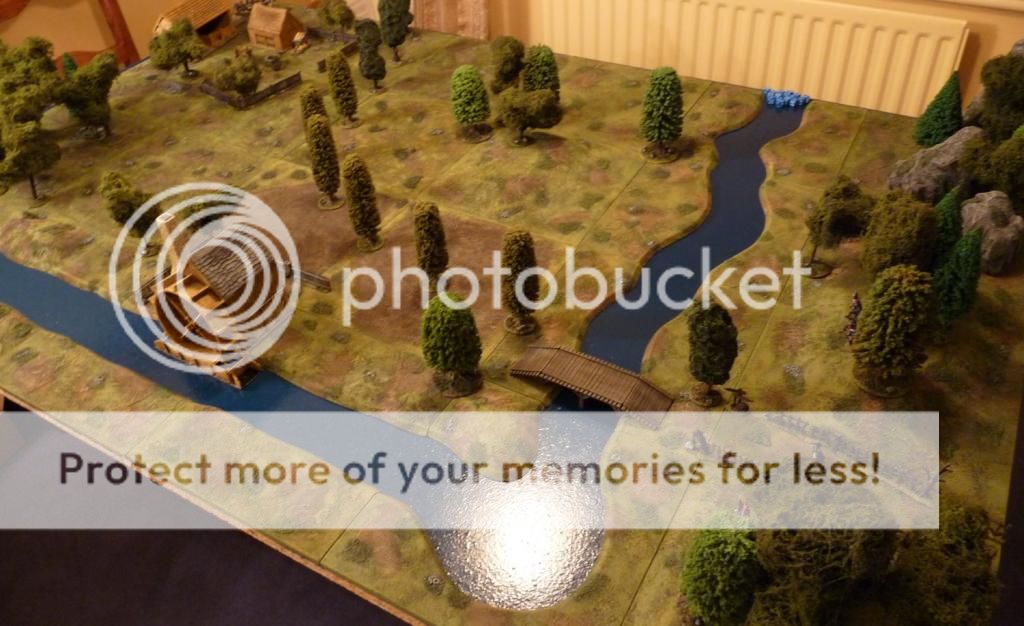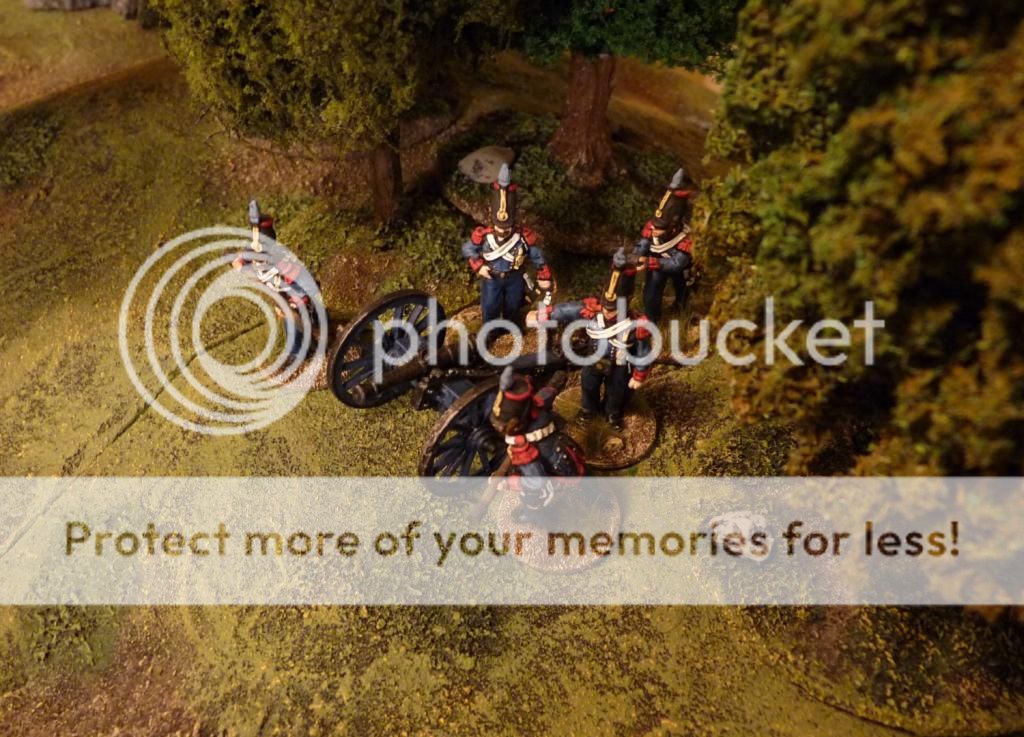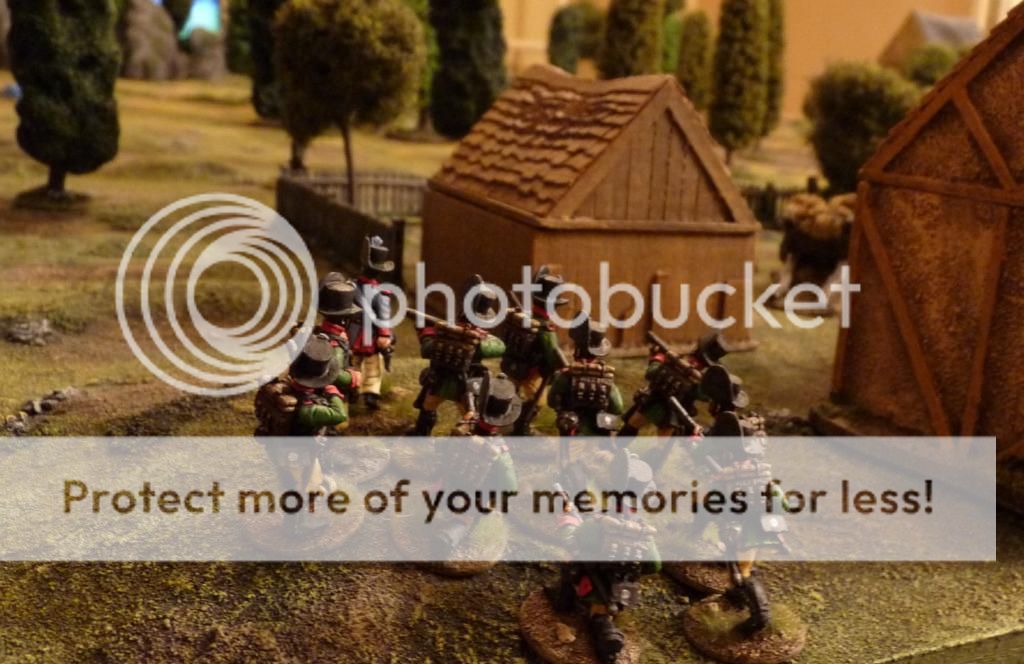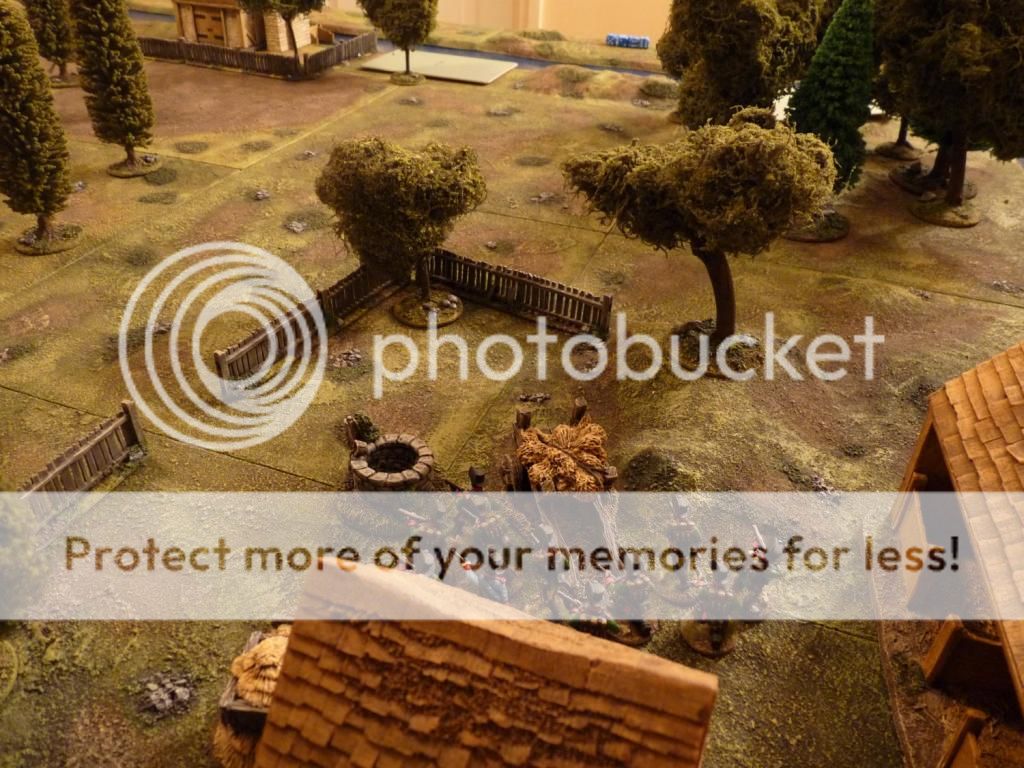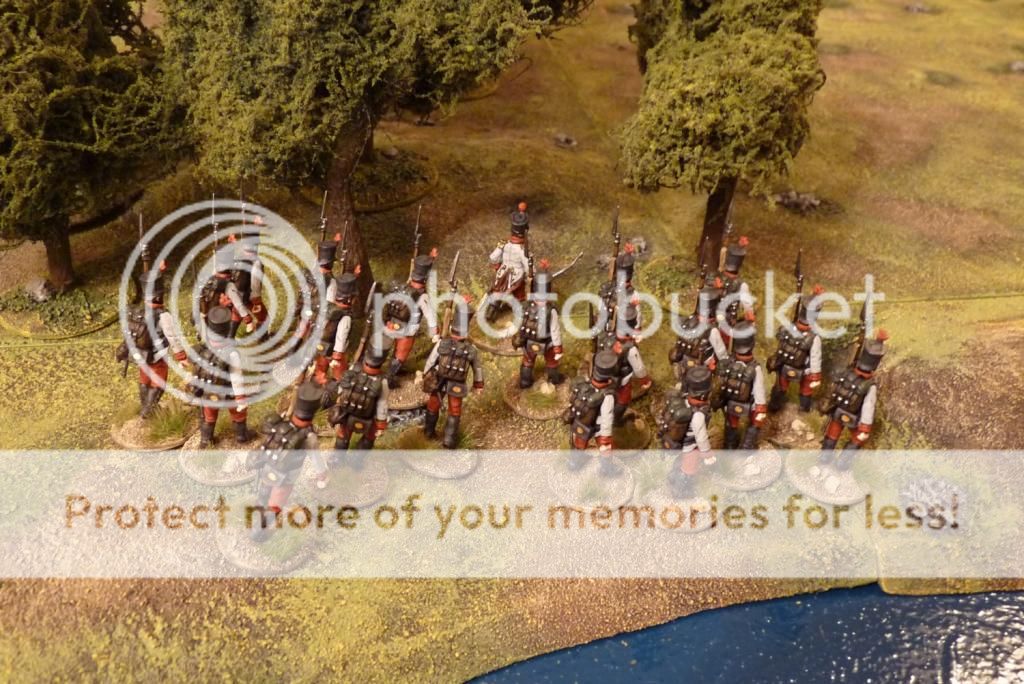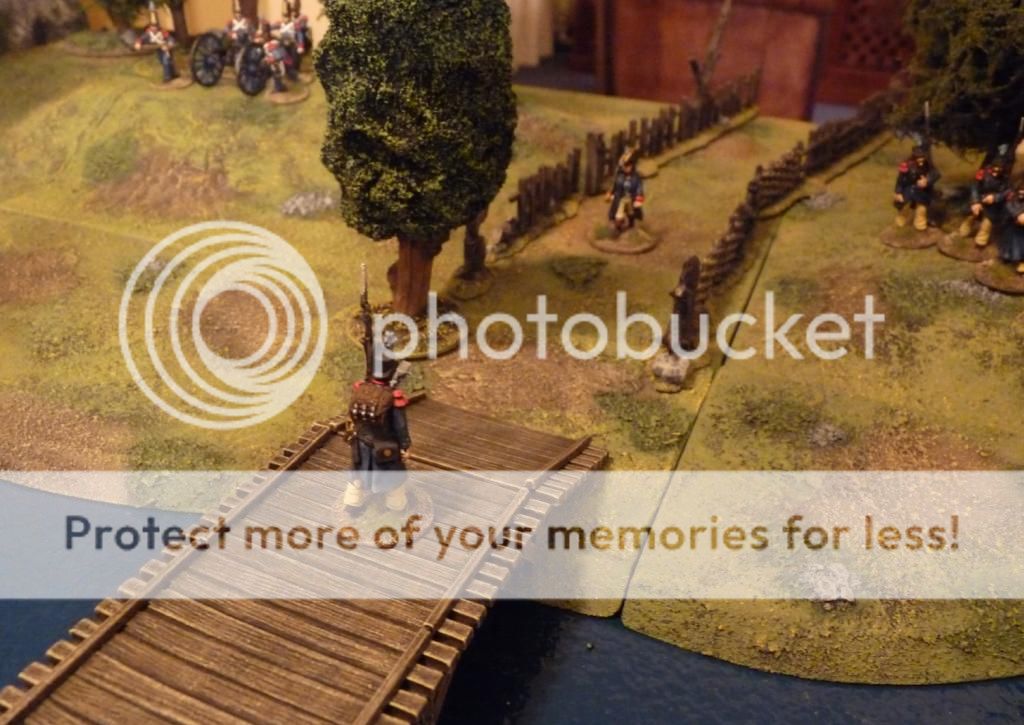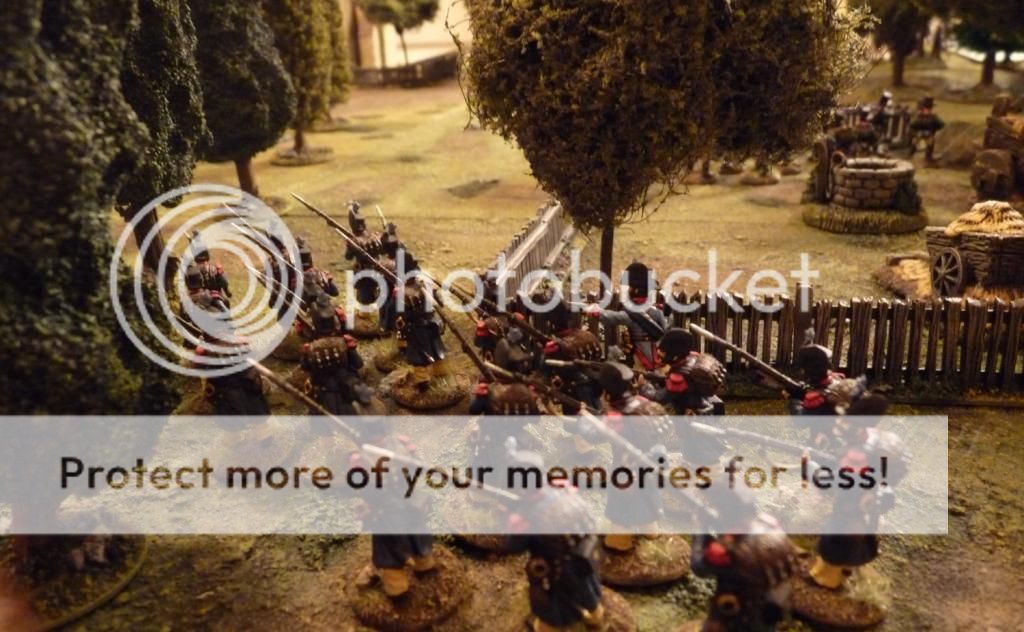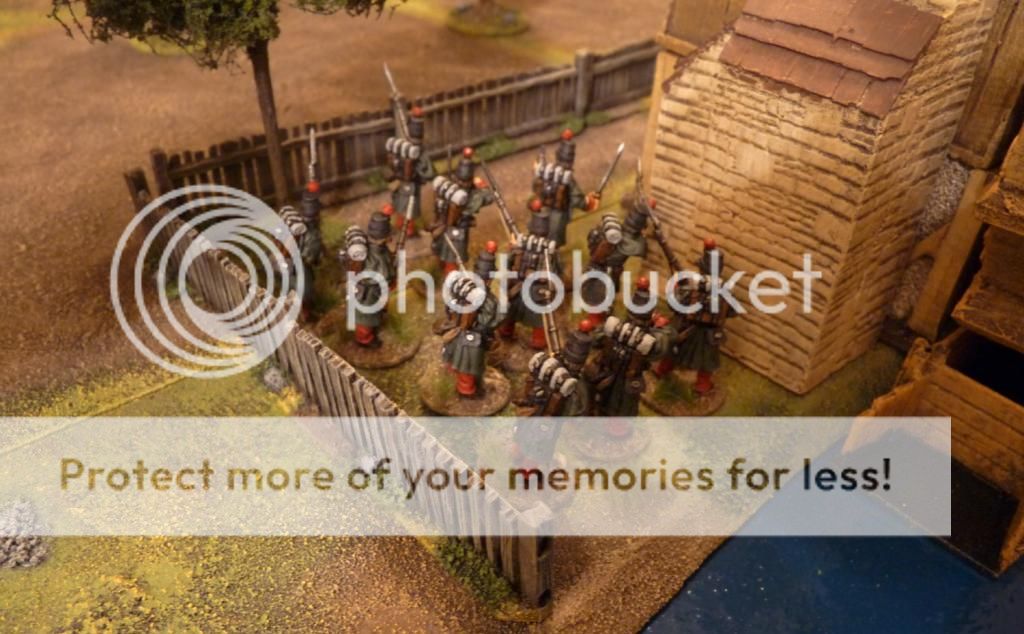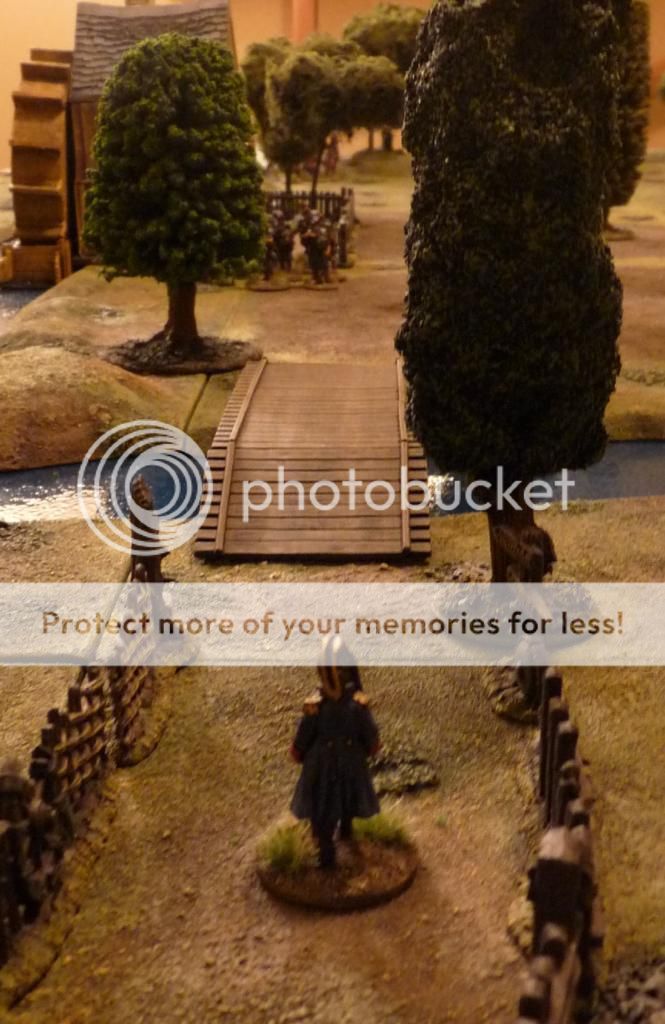I’m quite pleased to have made it to a hundred posts. You’re never sure with this sort of thing if you’ll keep it going or if it will just fizzle out. Anyway, it’s been fun so far so I’ll see if I can get to 200.
I didn’t have much new to post about but then, with Ayton 2015 fast approaching, I realised that I never did share my account of the Ayton 2014 campaign, other than with Henry Hyde. So, here is the official Medetian history, not too biased I hope, but naturally concentrating on my perspective of the pre-weekend planning and the on-table events themselves..
Ayton 2014 – Grenouisse Ascendant (but not for long..)
The Medetian Experience
The Plan
General Barolo, on finding himself appointed to the role of the Duke’s Chief of Staff, set about making the best of this dubious honour. Reining in some of the more impetuous allied commanders (Borscht and Darien
particularly) was the first priority so that a discussion could take place
about plans and timings. A conference was duly called and hosted by General Hauptzeige in the Governor’s Palace in Castell Sebastian. Numerous ideas were put forth, although geography, initial deployments and limited campaign time clearly suggested a two-pronged invasion, from the east by land, and from the west by sea.
With the Duke absent, the fact that the conference generated a reasonably
coherent plan, with everyone more or less in agreement, was a welcome surprise. That the various contingents’ own intentions (some of which were already being implemented!) were largely incorporated in the combined plan was no doubt the reason for such co-operation.
In short, the aggressive Borschtians, already occupying the
island off the Duchy’s southern coast, were to invade Granprix from west of the capital and its river lines. The Prunkland bridging column, kindly loaned by Hauptzeige, would go with them to assist in their advance east, and the doughty Wheyeydians would take ship to land in their support. Subject to what opposition they encountered, they would attempt to approach Pescadrix from the west and hopefully draw off a proportion of the defenders’ strength.
The eastern pincer would be a larger affair, with the main army departing Kap Ludwig and marching straight for Pescadrix, intending to smash through any opposition it encountered. The Medetians would lead on the
coast road, with light troops covering the hilly right flank where enemy advanced forces might be lurking. The rest of the main army would follow closely, consisting of the infantry and light troops of Darien, and the army of Prunkland, who would be last to depart. The Granprixian forces under the Duke would land by sea further along the coast and thereby link up with the main army, creating a combined (and hopefully unstoppable) force of over 2,000 figures.
The Darien cavalry, a mighty host in itself, would leave early and make its way north west through the hills and forests, aiming to cut the road north of Pescadrix and sever the enemy’s communications with Grenouisse. This force would then move south to close the net around the capital and hopefully re-join the main army for a final show-down close to the city. This part of the plan was altered mid-campaign as the cavalry column
would not have arrived in time, so instead the Darienite cavalry marched to the right of the main army and was close enough to be able to make a crucial contribution to both battles.
Substantial naval forces would carry out a number of operations, including escorting the Borschtians, Wheyeydians and Granprixians to their landing sites, scouting the enemy coast for activity and defences, covering the main army’s left flank from enemy naval intervention, and keeping an eye on things back at Castell Sebastian in case a coup de main was attempted by anyone (‘friend’ or foe). The weather was, as always, unpredictable but in the main these activities were carried out without too much mis-hap. Naval clashes took place, and a major battle is understood to have taken place late in the campaign, of which reports have not yet been received.
Many plots, intrigues and subterfuges were also planned during this period, and some were even implemented; a most interesting time it certainly was! General E Pickled, apparently dithering to and fro on the coast road, was shot and wounded in the arm despite his cavalry escort, leading to suggestions that his own side might have been responsible. The true motives of the Darienites and their Inquisition were suspected by many among the Duke’s allies, and efforts were made to observe their actions and restrict their access to the Kap once the army had departed. Prunkland in particular was sensitive to the risk of a coup in Castell Sebastian when the campaign was occupying our attention, and contingencies were put in place to defend against dastardly actions from disappearing cavalry columns, disguised infantry, mischievous feathered natives and sneaky naval forces.
Map of the
Granprixian Invasion Plan (click to enlarge)
Key:
Purple – Main Army; Medetia, Prunkland and Darien main force
Green – Darien Cavalry (although in the end they didn’t travel this far to the north)
Grey – Duke Zigor and his Granprixians
Red – Borscht
Orange – Wheyedia
The Campaign Itself
Somewhat amazingly, due to a combination of a reasonably straight forward plan, some curious enemy dispositions, a bit of luck, and a tremendous fighting spirit, the invasion proceeded very nearly as intended.
The enemy were unable to strongly oppose the main army and fell back before it, abandoning prepared positions without a fight. The army marched forward cautiously but in good spirits, eager to get at the enemy.
Granprixian guerilleros were encountered, providing intelligence, confirming that the enemy were out of position guarding against non-existent threats to the north west, and offering assistance in the coming fight. Both were welcome. Some naval skirmishes took place off the coast but, coming as they did after the key landings, without serious impact on the land campaign.
Finally, after a sedate march through the gentle Granprixian littoral, we found an enemy army that was ready to give battle.
First Battle
The enemy (the armies of Gateway and Altefritzenberg) took up a strong position anchored on the coast and village to their right (Gateway), with wooded hills and earthwork fortifications to their left (Altefritzenberg),
and with their combined cavalry in the plain between. Granprixian forces were assigned the extreme left of our attacking army, aiming to capture the village and had assault troops, led by their Grenadiers, literally advancing along the beach. The forces of Darien, Prunkland and Medetia occupied the centre and right of the army, with their units intermingled to give best advantage. A very strong cavalry force (largely from Darien) deployed to the right of the Granprixians, opposite the enemy cavalry. A mighty combined battery dominated the centre, and both close order and light infantry faced the hills and woods ready to advance and throw the enemy from them.
In short, the battle for the village was one of tough fighting and attrition, decided only when the enemy army retreated. Some local guerilleros also swept in by boat behind the Gateway line, intent on causing mischief and
confusion. Meanwhile the grand battery pulverised the enemy positions, and some of their cavalry, forcing the Altefritzenbergers to make the decision between being destroyed in place or advancing to their doom. They bravely chose the latter and, by coming to grips with our infantry down the slopes, actually protected themselves from much of the artillery’s fire. The skirmishes among the woods and ponds were prolonged, but a strong column of Medetian battalions, led by the Bravence Regiment, was pushing forward inexorably on the extreme right flank and when the enemy facing them finally broke, the end was in sight.
News of our large flanking movement to the north made by the rest of our
cavalry (some 130 figures) also hastened the enemy’s decision to give up the fight and save themselves for another day.
The true glory, however, was won on the plain where massed cavalry fought out a tremendous battle of charge and counter-charge. Splendid and in significant numbers though they were, the Gateway regiments, supported by those of Altefritzenberg, were no match for the seemingly endless hordes from Darien. Light cavalry soaked up the charge of the first Gateway wave, and the Darien Cuirassiers’ counter-attack was devastating. Three regiments fell to them in one turn, and in the confusion the legendary General E Pickled was cut down and ridden over while his cavalry fled. Rumours of his death were exaggerated and he has since retired to his estates. His cavalry Brigadier was captured in the same melee.
Although further Gateway battalions and batteries deployed to cover their cavalry’s rout, they could only serve as a rearguard while the rest of their battered army left the field to our victorious troops. Casualties had been mercifully light, and we needed only a day to re-group and resume our
march west to liberate Pescadrix.
Second Battle
After a day’s rest a short march took us to within sight of the ramparts of Pescadrix, our final objective. The army pivoted on its left flank, which hugged the coast, and swung around to the north of the city, penning the enemy back against it. Our naval scouts informed us that our Borschtian and Wheyeydian allies had fought an indecisive battle to the west two days before and had re-embarked on their ships to land again between the
enemy and the city. General Barolo sent them a message urging them to send a force to approach the city from the west and capture the main bridge over the river.
The enemy again entrenched and made use of what buildings they could in their defences. The Gateway forces deployed in front of the city while to their right were the Altefritzenbergers behind what earthworks they had prepared in time. The enemy right flank hinged on the customs house, which they’d fortified, and bent back to end literally in the surf. A buzz went through our army when it was revealed that the dastardly King Raoul himself was commanding the Grenouissian troops on that flank.
Fittingly, it was the army of Darien, whose priests had recently ex-communicated the King for his un-Christian ways (and, perhaps, for not granting Darien some Granprixian land in exchange for turning a blind eye) who opposed the Grenouissians. Once again massed cavalry would thunder across the plains.
In the centre, to Darien’s right, were the Prunklanders, ready to descend from the hills and capture the customs house in conjunction with their Darien allies. The right flank of our army was held by the forces of Medetia, with infantry and cavalry (including some regiments borrowed from the rest of the army) facing off against their counter-parts from the Gateway Alliance. The forces of Granprix itself had marched on a wider arc to the north and were due to come down the main road later in support of the Medetians.
Our battle plan was to pin the enemy in front of the city while rolling him up from his right flank, along the coast. Again, despite suffering setbacks and significant casualties, this plan was successfully executed, culminating in the capture of the despised King by Darien’s cavalry as his right flank collapsed.
Again a grand battery from Prunkland and Medetia covered the centre, smashing enemy units at will once it had won the fierce counter-battery duel with which the battle commenced. While the Darien troops swept across the plain, driving back the Grensouisse cavalry and assaulting the customs house, Prunkland supported them and held the centre. The Medetians engaged their Gateway foes and, while the light infantry fought each other to a standstill, the cavalry (led by Prunkland’s finest Cuirassiers) repeated the trouncing of the Gateway mounted arm that they suffered in the first battle. Three fine units were routed and a beautiful standard was captured. With things looking bleak for Gateway, their artillery, supported by the numerous heavy guns on the walls behind them, prevented a general collapse and took a heavy toll on our forces. The Medetian Weissach Grenz, El Z’Teeth Lancers and Rutowski Dragoons were each destroyed trying to come to grips with the Gateway batteries, sacrificing themselves to save the rest of the army from the murderous close range fire.
A cavalry thrust from the Wheyeydians on the other side of the river almost made it to the bridge, but a sudden sighting of Hunmanby’s landing on their southern flank drew them off before they could imperil the Gateway left flank and threaten the city. In their place came Granprixian fanatics and more guerilleros, braving artillery fire from the walls as they swept downstream in their boats. Despite losses they captured the bridge and landed beneath the walls themselves, opening fire on enemy troops there.
Final charges and last stands on all parts of the western battlefield saw dramatic and heroic actions on both sides, but when news of the King’s capture spread the heart went out of the enemy and the fighting began to
die down. Gateway and Medetia commanders signalled a tacit ceasefire and the brave defenders began to withdraw into the city, where their fate would no doubt be decided by diplomats eager to extract what advantages they could in the peace negotiations.
The word is that Raoul might be ransomed, but what was not in doubt was that Granprix, and in particular its finest jewel Pescadrix, would be returned to Duke Zigor. The army was victorious and, despite the sadness of its losses, the celebrations would reverberate for days!
So ends the account by General Barolo of the liberation of Granprix, this year of Our Lord, 1748.
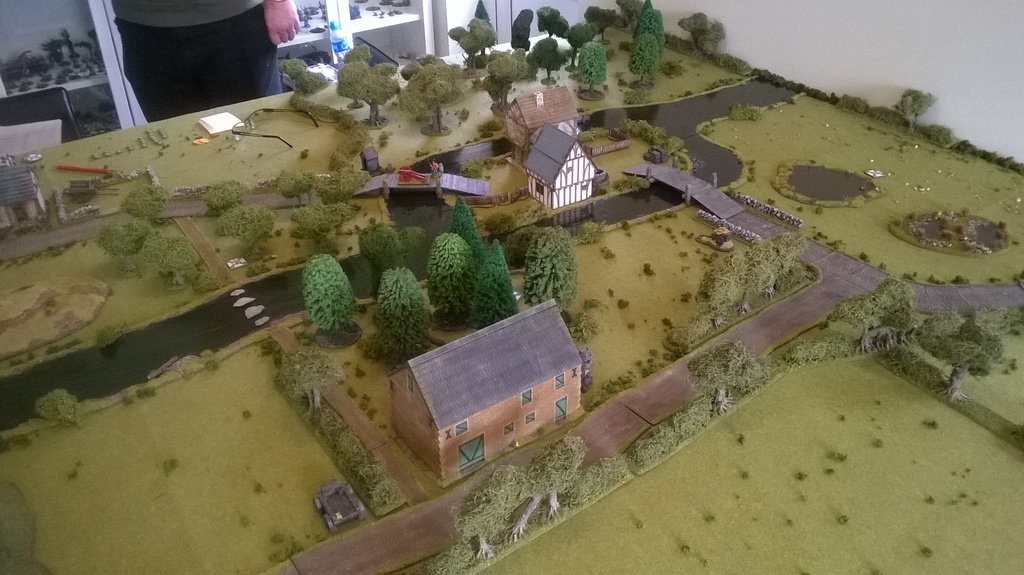
Once we had breakfasted and returned to the land of the living, we set off in convoy (herding Iain between 2 cars to ensure he found the place) for Simon’s house near Lincoln. We were greeted by very nicely pre-prepared terrain, including excellent new home-made rivers, on Simon’s extended 8’x6′ table.
A very interesting (and entertaining, as it turned out) scenario had been prepared for us. We were to play out some post-Ayton 2014 action, with Gateway (Iain) and Altfritzenberg (Andy) forces making for their transport ships along the Granprixian coast following their defeat at the big battle outside the capital Pescadrix. My Medetians were trying to cut them off, while a small number of Simon’s Prunklanders were already in place as a (sleepy) garrison on the island in the river that the fugitives needed to cross.
We all got to bring our own figures to use, and it was good to see the various imagi-nations contingents together again. The 4 of us had fought opposite each other in 2 battles at Ayton with the big version of these forces so it was an opportunity for a re-match, and there was plenty to enjoy!
The table before the mayhem ensued:
There were lots of surprises in the scenario, and as usual the Sharp Practice rules threw up plenty of entertainment. Although new to the rules, Andy and Iain got on with them very well. We played a lot of turns, had a lot of laughs and banter, and got a result before it was time to go home.
I won’t try to narrate the battle and all of its twists and turns, but I’ve captioned the pictures I managed to take. Hopefully they do the game justice, because it was great to play in as well as being a visual treat..
Deploying off a blind, Iain’s Gateway dragoons made it to the bridge quickly. They just missed catching the sentry but had time to dismount and push the unattended cannon into the river. This was to be their high point in the game, and after this most of their actions should have been accompanied by circus clown music!
Alerted by the sentry just in time, the Prunkland Grenzers dashed out of the main house on the island, to take up a defensive position in the adjacent garden:
Troops were arriving on both sides of the river, racing in parallel towards the bridges. The Medetian Jager led the way, buying time for the rocket battery to set up on a handy hilltop with a very good view of everything:
Andy’s Altfritzenbergers decided to get across the river early, which involved coming at the Medetians head-on. Some very accurate (ie. lucky) fire made this a real challenge, however:
Up ahead, the bulk of my Medetians had made fast progress and were able to take the dastardly natives and corsairs (who had infiltrated deep onto the table from the start) by surprise:
Andy’s natives charged over the bridge but were seen off by the tough Grenzers. Their officer was badly wounded in the melee but his popularity meant that he was rescued and helped to safety:
As always, the first rocket wasn’t a great shot, landing behind the battery(!). The safest place to be is generally the target zone, as everybody knows:
After a volley or two it’s always best to follow up with the bayonet, and these Medetians did just that, dealing decisively with the corsairs and seeing them routed off the table:
Iain’s Gateway mob stormed over the bridge, or at least they would have if in front of them his dragoons hadn’t decided to dismount, mount, not move, and dismount again in successive turns. Answers on a postcard if anyone has a clue as to what was going on:
Hey, the rockets were getting more accurate. I’d like to reassure people that no enemy were killed by a rocket during the making of this game (sadly, one Medetian was however), although they did cause a fair bit of panic a couple of times when they zigzagged through a unit!
Late on my elite grenadiers finally arrived by boat and soon attracted enemy fire from a variety of sources, as well as a pretty determined cavalry charge by Andy’s lancers. Tough as nails, the grenadiers saw them off though:
The latest attempt to chase off the Grenzers saw a repeat of the charge of the natives – Iain’s commander was laid low and his men routed. Unfortunately, this chap was less than popular with his men and they were careful to leave him behind when they fled! The Prunklanders reloaded and left him groaning on the other side of the fence, where they could keep an eye on him:
More surprises arrived; locals with an agenda of their own – but who would they side with?
The Gateway traffic jam finally clears the bridge, allowing my grenadiers to pick off sufficient of Iain’s artillery crew to send the remainder packing. At least Prunkland might get a replacement gun at the end of the game! This was the beginning of the end, and the survivors would have to find another route if they were to reach the safety of their ships.
After having a very torrid time (a rocket came awfully close!), Lt Lamm scampered out of harm’s way and rejoined his men just in time to be captured at the end of the battle. At least he wasn’t shot in the back as he legged it into the woods having crossed the river alone (actually he had company for most of the journey but when he reached the far bank and looked behind him, he realised that another close call from a rocket had been the final straw for some of the Savage Swans and he was suddenly Billy von No Mates with a nasty looking bunch of Medetians coming for him!)
A well-oiled machine by the end of the game. Oh yes.
What a great game. Thanks to Simon for all the prep and hosting, and Andy and Iain for providing such good fodder, er, I mean company.
Roll on the next gaming weekend!

Last weekend I was privileged to take part in, and share the hosting duties for, a 4 player gaming extravaganza that more than lived up to expectations. I was offering massed 6mm on day 1 and Simon provided a large 28mm skirmish game on the 2nd day. Our guests Iain and Andy came from opposite ends of the country to do battle, socialise and exchange banter. We even squeezed in an excellent night out between games.
On Saturday morning everyone picked up a baton and took command of a corps in a Franco-Prussian War battle between 50,000 French and 60,000 Germans. I (as General Douay of VII Corps) assisted Iain (Marshal MacMahon, I Corps) in attempting to hold the important (but slightly fictitious) town of Hoffen, near the border on day 2 of the German invasion. Fighting alongside each other, but with neither in overall command, Simon took the role of Prussian General Kirchbach of V Korps
and Andy was General Von der Tann with the Bavarian I Korps.
The French had a division from each corps already on the table. They had arrived the day before and camped, digging in a little, overnight. The Prussians and Bavarians were marching onto the field from the north, unsure of each other’s position or that of the enemy. Everyone had a number of arrival points for their marching columns and reinforcements. These were pre-determined by the players for new arrivals before each turn and led to some interesting dispositions and confrontations.
The table before the battle:
Unfortunately my usual camera was away from home, so these pictures were taken on my phone. Hopefully they at least convey the gist of how things looked.
In typical wargamer style, not everyone had read the briefing or the introduction to the rules (To the Last Gaiter Button by Realtime Wargames). I set the scene to the uninitiated, and provided lots of coffee to help.. Nevertheless, before too long hordes of horse, foot and guns were trampling over the previously tranquil Alsace countryside and some serious fighting erupted across several miles of front.
I threw my French forward to stop Andy’s Bavarian horde from enveloping Hoffen from the east, and managed to put a dent in his advance, tying up his forward troops and drawing in reserves. Iain and Simon competed to build up the stronger force to the west of the town, using newly arriving formations wherever they could to keep the initiative.
Early moves:
The battle in full flow:
The escalating fight to the west of Hoffen, between the French and Prussians:
My beleaguered French in the village of Seigen which they used as a bastion against the Bavarians (I borrowed these beautifully scratchbuilt buildings, and some of the trees, from a very generous friend):
French cavalry launch a desperate charge, which took the fight out of the Bavarians in the same turn that the Prussians to the west reached a similar state of exhaustion:
It was a close thing though, and a few more turns might have allowed the Germans to capture the town. It wasn’t to be, however, and in the end they had to fall back to await assistance from the rest of 3rd Army before trying again.
Everyone seemed to enjoy the game and got to grips with the rules (which are very different to the norm) pretty quickly. The Germans never really got their artillery superiority into play fully, which was probably down to my hasty pre-game rules briefing which seems to have led to the commanders deploying their guns a little early! Oh well, it was only day 2 of the war and they’d have to learn as they went back in the day too!
The Chassepot did its bit, the Mitrailleuses were unpredictable and quickly targeted, and the Zouaves seemed to fight ferociously when cornered. With the cavalry being used as expendable shock troops (as they sometimes were in the war) the game provided a decent flavour of the period, and especially the command and control challenges experienced by the generals.
For another perspective, a very good write up and lots more pictures visit Andy’s site: Belisarius.org
It was a great day, and we topped it off with a night out in Newark, enjoying beer, curry and some strong spirits to finish. The full English breakfast in the hotel was very welcome in the morning, and got us going ready to tackle whatever Simon had in store for us on the Sunday – part 2 to follow..

Before everything got tidied away it would have been rude not to have had a final Sharp Practice bash, so I did.
I decided to try more of a stand up fight so this time the scenario was straightforward – the Medetians were launching a campaign into Fleurian territory and their vanguard needed to clear the way by exiting at least 2 groups and a big man off the Fleurian table edge within 12 turns. The Fleurians needed to stop them of course. It was a deliberate attempt to get a few more figures on the table and see how the rules dealt with it.
The defending Fleurians were partly in place (occupying a roadside farm in the middle of the table) but mostly advancing from their own baseline. They had a force under the newly painted Major Mauzac, made up of:
32 light infantry in 3 groups
20 line infantry in 2 groups
1 light gun and 5 crew
12 militia cavalry in 2 groups
3 additional Big Men
The Medetians were under the fit-again Major Nebbiolo, assisted by a command group of 4 other Big Men. Between them they commanded:
10 bersaglieri riflemen in 1 group
50 line infantry in 5 groups
24 grenadiers in 2 groups
1 light gun and 5 crew
10 hussars in 1 group
I’ve decided to go with fixed group sizes depending on troop quality; elite, average and poor. Infantry are in groups of 12, 10 and 8 respectively and cavalry are in groups of 10, 8 and 6. Some of the Medetian infantry were on group bases to assist with the early moves in particular, and I was trying out some new markers I’d made up for various things (such as for groups who’ve lost their Bottle and to keep track of some of the random events).
With a game limit of only 12 turns, and a card-driven turn sequence that ends on the turning of a certain card, the Medetians had to attack from the start to have a chance of beating the clock. They were in pre-determined groupings that would be allocated at random once the blinds were successfully spotted by the enemy. With more troops involved I managed to use formations for the first time, each side forming a line during the battle to ease command and control and increase firepower.
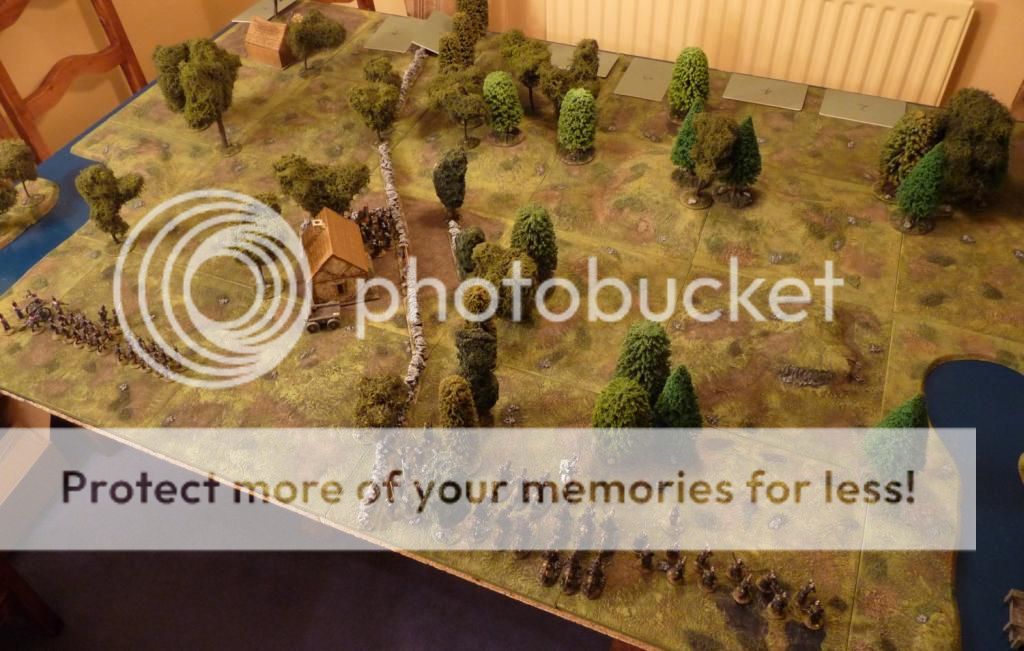
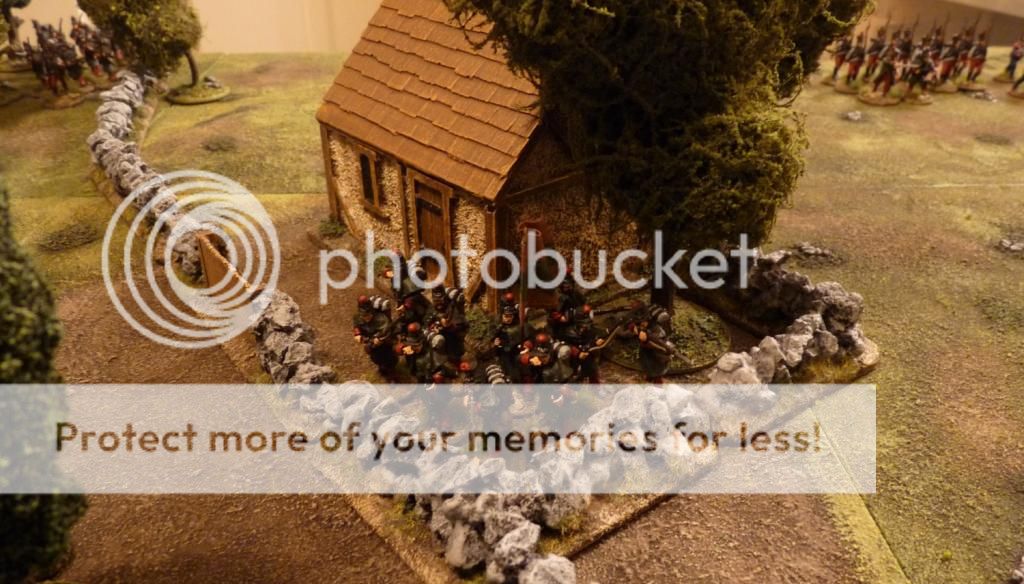
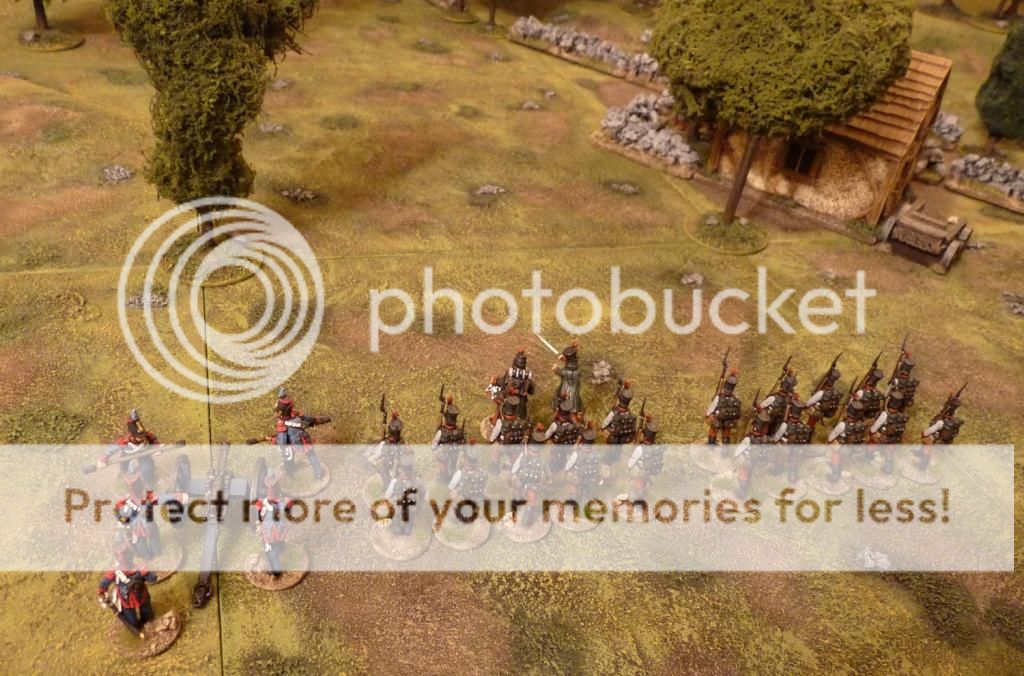
The fighting built up slowly but became pretty intense once the Medetian infantry advanced into the open. The Fleurian elite voltigeurs were particularly unfortunate, being targeted by the bersaglieri rifles and eventually being run down by the hussars. Equally, the Medetian grenadiers were badly shot up in front of the farm, and the right flank was very slow in coming forward to support them (held up by poor luck with the cards and the fire from the Fleurian light gun). These right flank troops seemed to suffer from a general lack of discipline on the day, with a man passing out drunk and careless musketry causing the adjacent barn to catch fire and burn down!
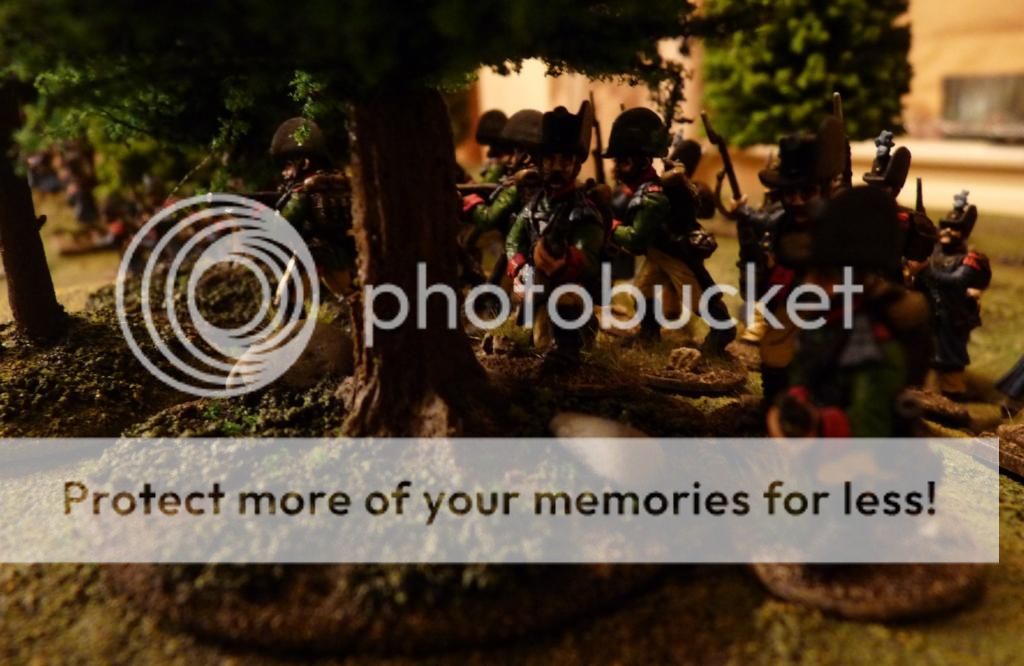
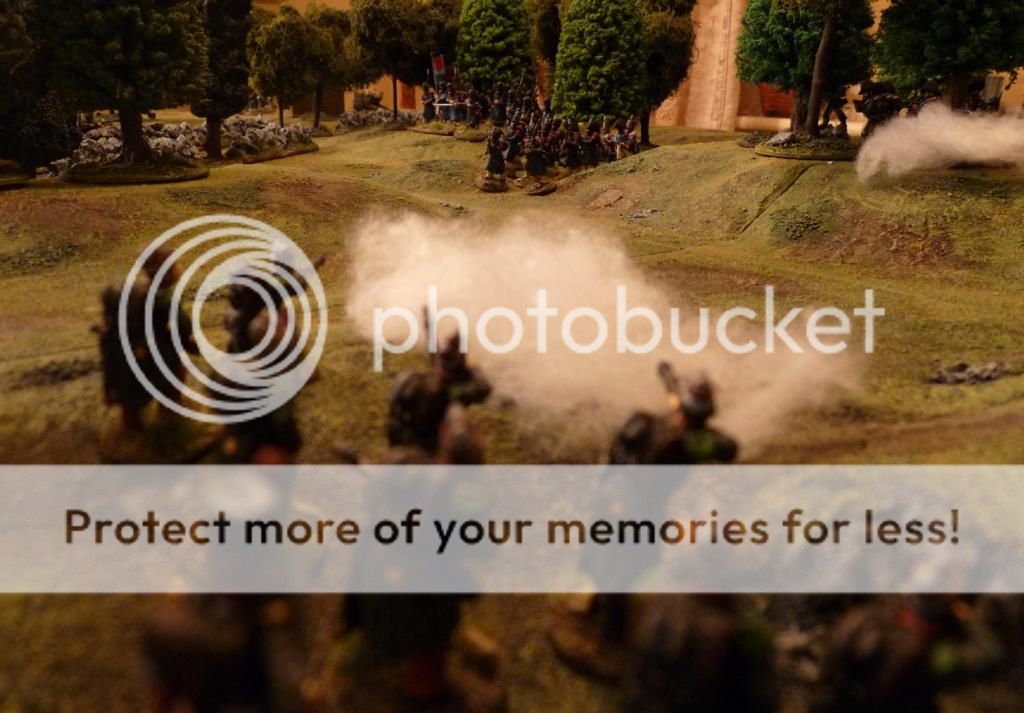
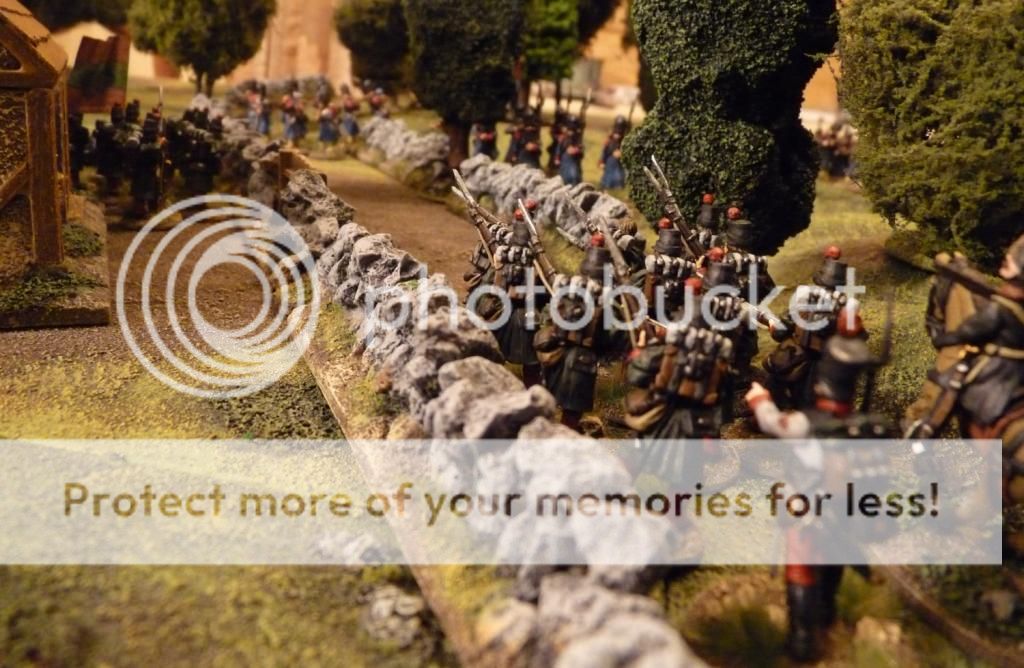
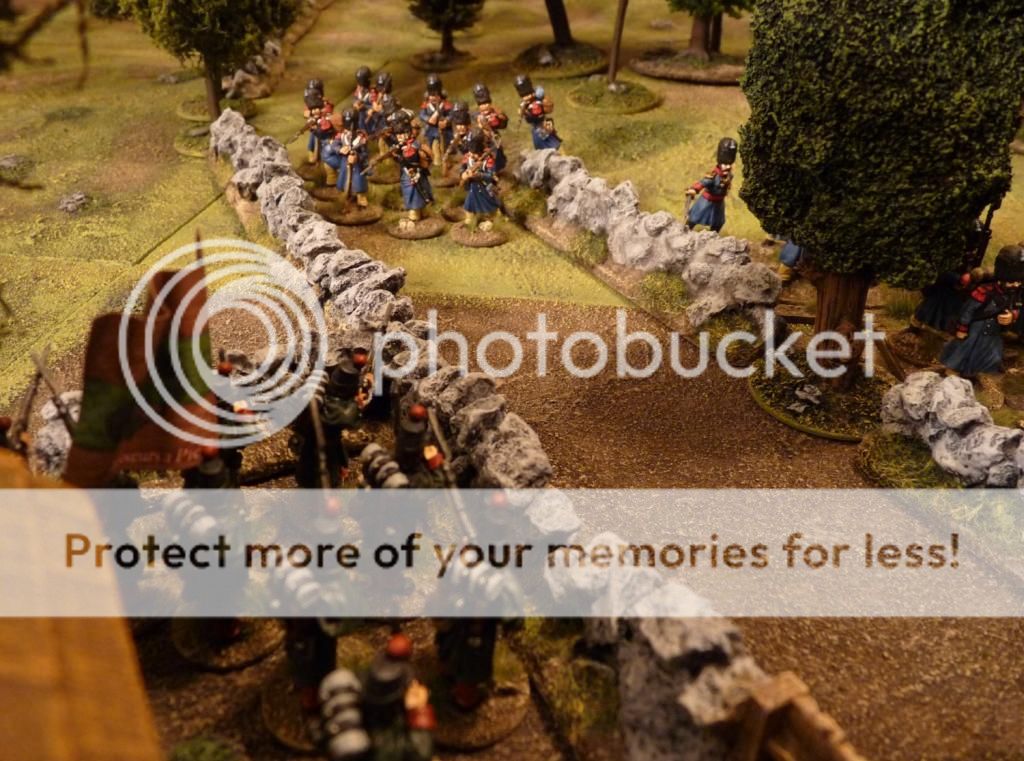
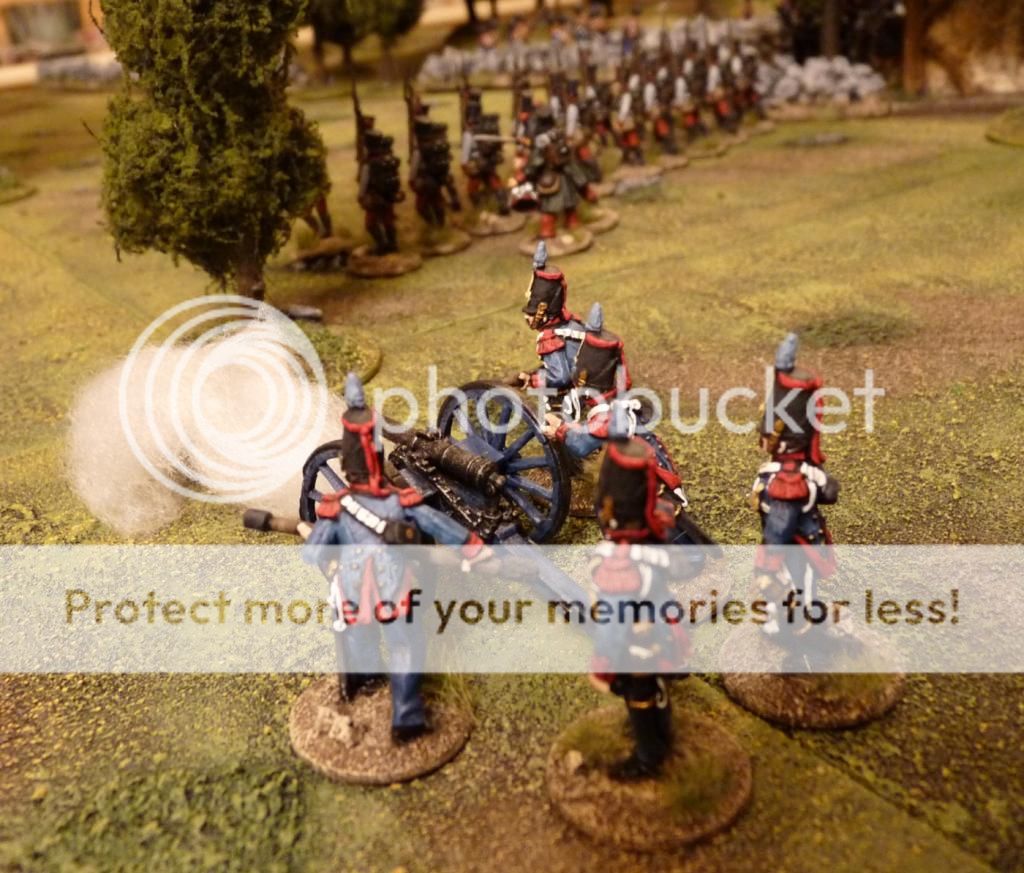
Despite the grenadiers’ woes a Medetian success looked likely, however, with numbers beginning to tell on the left. However, a few unexpected reverses and a surprisingly tough stand by the Fleurian militia cavalry put everything in doubt. Two groups of infantry were therefore ordered to form up in line and marched forward to try to break through. Things then descended into a series of violent melees that saw victory within the Medetians’ reach.
At the start of the 12th turn Major Nebbiolo (sporting a sprained ankle) had to try to get into line of sight to order the hussars to join the rifles in moving off the Fleurian table edge. He had to use all the available Grasp the Nettle cards and roll a big enough move to do it – he rolled an 11 and even with the penalties for his injury he made it and ordered the 2 groups to move, winning the battle and forcing a Fleurian retreat. A close run thing, but very entertaining to play.
The final turn, with Nebbiolo (between the flag and drummer) finding the hussars frustratingly out of sight behind the trees:
Once again there were casualties among the leaders, although still nothing terminal. Notably Ensign Lambrusco again did well but this time succumbed to a bad wound and was carried off the field by his men. I’m sure he’ll be back when I play again. For now, though, I’d better get back to the painting table!
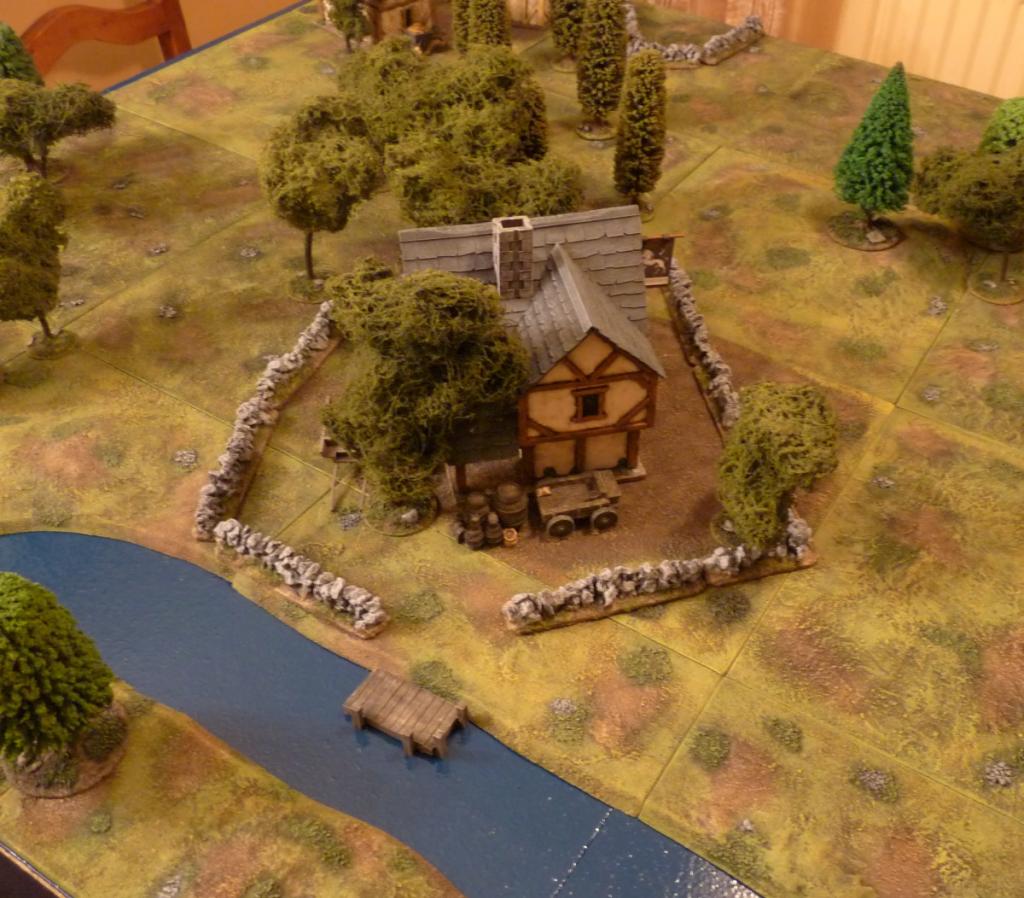
With the table still set up I thought I’d have another game of Sharp Practice, like you do. So, the Fleurians decided to take revenge for the recent Medetian reconnaissance raid that had caused so much bother.
A little to the south of the bridge scene from the last game sits the village of Chiesa, with the Griffon Inn (a favourite haunt of off-duty Medetian officers and a regular stop-over for wealthy merchants) nearby. Burning the inn down, capturing idle officers and possibly making off with a bit of loot would be a good way to pay the enemy back – and in the detested, but tough, Major de Grenache, the Fleurians had just the man for the job.
The Griffon:
De Grenache gathered a raiding party from his regiment, made up of 20 line infantry, with a further 20 chasseurs and 12 elite voltigeurs drawn from the light companies. He was assisted by a junior officer and a veteran sergeant. The force approached the inn at dawn, entering the table on blinds and moving swiftly forward.
The unsuspecting Medetians were scattered and asleep, with only a single sentry (who turned out to be sleeping on the job..) posted. Major Nebbiolo was in the Griffon after a bawdy night, with some riflemen down in the taproom and a group of line infantry camped in the trees behind the yard. In the village were young Ensign Lambrusco and Sergeant Gerduzzo, who between them commanded a further group of infantry, one of elite grenadiers, and a light gun with its crew.
The sleeping sentry (his card failed to come up for the first 3 turns) was surprised (to say the least) when the Fleurians sprang out of the early morning mist and made straight for him! He legged it and called out his alert but was captured before he get get over the wall and rejoin his comrades. The net was closing in and the Medetians were still stumbling from their beds and blankets.
First to react, the grenadiers looked decently smart when they piled out of their village billets and took up a defensive position:
Table overview at this point, the Medetians haven’t exactly established a defensive line yet:
Things soon descended into typical chaos and violence as the fighting began. The grenadiers held the flank and their fire forced the voltigeurs to seek cover in the trees. In proper grenadier fashion Sergeant Gerduzzo led them in the first of several bayonet charges and routed the enemy skirmishers, before following on to offer support to the beleaguered Major and his rifles at the inn.
The rifles had done well initially, spilling from the front door and shooting down a number of the enemy attackers, Major de Grenache among them. He slumped to the ground where his men, grateful to be freed from his vile oppression, happily left him and followed the second in command over the wall and into melee with Major Nebbiolo and the riflemen.
The Medetian Major was struck down too and his remaining men were pursued into the building where, despite a death-or-glory charge back down the stairs after they’d taken refuge above, the last 3 men dropped their weapons and surrendered to the victorious Fleurians. The new Medetian leader, Captain Verona (also wounded in the fighting) derring-do’d his way out of the upstairs window and hurt himself again as he came down in a merchant’s wagon out the back..
A little dazed, he took charge of the men who’d been camping behind the inn and tried to regain control of the situation. Unfortunately for him, Captain Corbieres had stepped into de Grenache’s shoes, as it were, and led his men on a successful ransack of the Griffon, before setting fire to the spirit store and evacuating again via the front door.
The fighting continued with both sides blazing away and the artillery piece taking pot-shots when any Fleurians wandered (or were chased) into view. There was plenty of hand-to-hand as the Fleurians sought to get away, their mission complete. Both Captain Corbieres and his adversary Ensign Lambrusco (valiantly leading a charge in his first action) received light wounds in these clashes. Eventually the remaining Fleurians who hadn’t already routed made a fighting withdrawal and the exhausted, and equally bloodied, Medetians let them go.
The inn burnt to the ground while the Medetians tended to their wounded (including Major Nebbiolo), and dragged the bleeding and abandoned Major de Grenache into captivity. With both his senior officers wounded, 18 year old Ensign Lambrusco found himself temporarily in charge of the mess but, like any sensible Medetian young gentleman fresh from the academy, he started to make order out of chaos and soon forgot the pain of his bandaged arm. Welcome to the war!
Good fun and plenty going on every turn, the Sharp Practice rules make solo play a pleasure and all the prep has certainly been worthwhile.
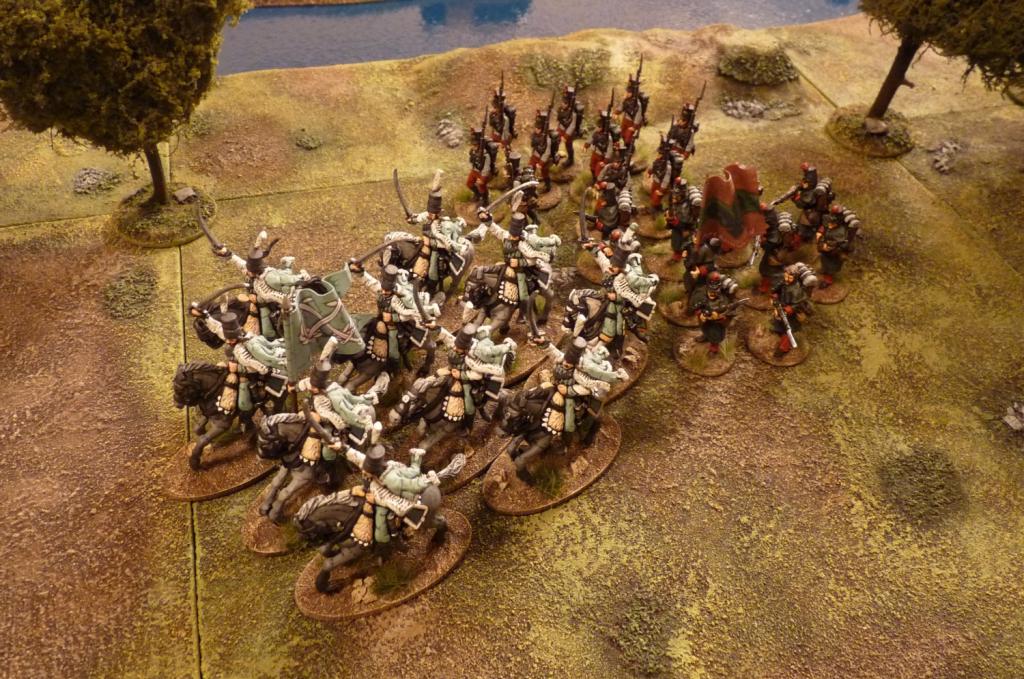
Following the steady build-up of troops on the table, after a few turns things started to kick off. I’d rolled randomly for which Fleurian groups were on which blind, and sure enough the cavalry suddenly appeared, making for the middle of the table to cut off the enemy. The Medetians looked warily to their right but were ordered to march on.
The riflemen in the farmyard took a shot as the hussars swept past and managed to empty a saddle, but the rest rode on:
The rifles had problems of their own, however, and an enemy infantry group almost reached them with a charge from the woods. Halting just on the other side of the fence the Fleurians taunted the riflemen, challenging them to a rumble:
Remembering their mission, the rifles said ‘thanks, but no thanks’ and made a hasty departure:
At that point the Hussars hit the lead infantry group, winning the close fight and wounding Captain Gattinara. Although pushed back, the Medetians refused to run and were saved by their comrades in the other infantry group, (and the rifles) who charged the cavalry in turn and saw them off with heavy casualties. That was the last we saw of the horsemen in this game.
At the bridge, the artillery held back the Fleurian Chasseurs and managed to wound Captain Corbieres. A long firefight ensued between the Fleurians trying to close the bridge escape route, and the defending Medetians, who were increasingly aided by their arriving comrades under Captain Gattinara.
The rifles continued their excellent work, acting as rearguard and stopping the pursuit in its tracks:
Several of the final turns were cruel to the Fleurians, with the Cappuccino Card (replacing the Tiffin Card – we are in southern Europe after all) ending them before their Big Men could act. With the Medetians able to pour in enough effective firepower to build up Shock on their pursuers, they eventually managed drive them back from the bridge, and prevent a final counter-attack.
Wounded but victorious, Captain Gattinara was the last to cross the bridge. He turned to salute the similarly injured Captain Corbieres and marched his men off into the woods. The Medetians had suffered only light casualties and had succeeded in their mission, bringing back valuable intelligence from behind enemy lines. The Fleurians had lost many more men, and these units would be in no state to fight again for some time.
The game was great fun, with the cards providing suspense and drama (Captain Gattinara fleeing in fear and dragging his men away with him just as they were nearly at the bridge for the first time, being a particular classic!). The characters have begun to take on a bit of personality already and I look forward to returning to this small part of the Medetian Wars soon. Next post will contain a few summary comments and observations about how I got on with the rules, etc.
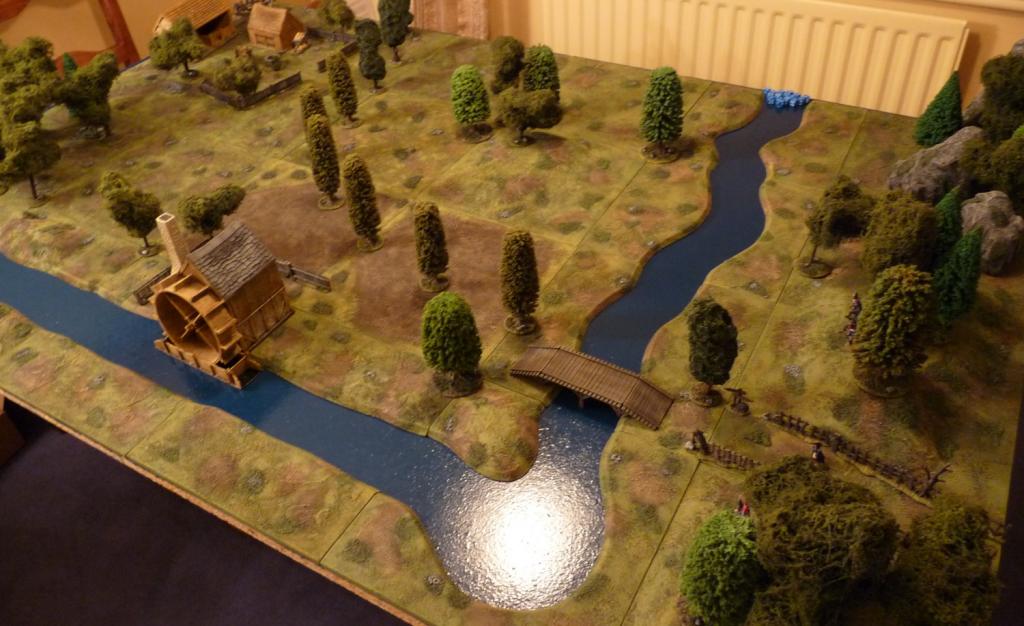
With the cards and figures done, and the terrain still on the table, there was no excuse but to try a first solo game of Sharp Practice at the weekend. I devised a relatively simple scenario based on a Medetian reconnaissance force making its way back to its own lines after its mission, and a force of Fleurians attempting to cut them off before they could do so.
The Medetians (2 groups of infantry and 1 of rifles) were led by Captain Gattinara, assisted by a Sergeant. Waiting for them back at the bridge they were making for was Lieutenant Apricale with a further group of infantry and a light gun, with orders not to cross the river but to provide covering fire for the recce force.
The Fleurians were under Captain Corbieres of the Chasseurs who was accompanied by a scratch force made up of 2 groups of light infantry, 2 of line infantry, and 1 of hussars. He was assisted by a Lieutenant and a Sergeant.
The Medetians would start in the top left corner of the table, as seen in the (unfortunately slightly blurred) pic below, the Fleurians on blinds in the bottom left along the river bank, and the bridge defence force was tucked into the trees on the Medetian side of the river, with a sentry on lookout duty in the watermill’s attic.
Lt Apricale’s force covering the river crossing:
First on the scene – the Medetian riflemen approach the rear of the farm and dash through to take up a position to cover the flank of the rest of the column (first enemy blinds in the distance making for the mill and the bridge beyond):
First to deploy off their blind are the Fleurian line troops, their paint still fresh(!):
The Medetian sentry has done his bit and races back to warn Lt Apricale that the enemy are coming down the road towards him, with the recce group nowhere in sight. Alone, and chased by enemy Chasseurs, the sentry managed a fear-inspired roll of double 6 for his movement! He slows down and tries to look nonchalant as he makes his report:
A long way off still, the main recce group starts hot-footing it towards the river, Captain Gattinara urging them on:
Fleurian Chasseurs are already at the mill though..
The rifles take the first shot of the day, earning their pay by putting a good amount of shock on the nearest enemy as they try to sneak close through the trees:
Back at the bridge, Apricale sees the enemy for himself and calls out to ready his men, ordering the gun crew to traverse left a little:
Things are about to hot up!
Part 2 to follow, mainly to keep the number of pictures to a manageable number per post.



































